Charles
Schleicher - Belle Vallee (aka Carl Schleicher & Söhne):
History
(Note:
Initially, researching this company was a bit difficult for several
reasons. First it was a German needle
manufacturer, and many records are only in German which are sometimes hard to
translate. Researching German records is
also different from UK and USA records because Germany did not become a country
until 1871 and records from various areas are different or do not exist. This needle company was from the Aachen,
Germany area which was part of Prussia before 1871. Aachen is located near the border with the
Netherlands and Belgium and some records are in French or other languages. In addition, the Schleicher family from this region
was quite large making it sometimes difficult to tell which son was from which
father. Also, there is some conflicting
information on the internet about the Schleicher family members and it is
difficult to know which is accurate without further evidence to prove it. In April 2025 a copy of a book which was
written in 1919 to celebrate the 100th anniversary of the firm Carl Schleicher
& Söhne[1] was
discovered. This book provided
additional information about the history of this company. Therefore, the Schleicher history below is
based on what appears to be most accurate and what makes the most sense,
however, be advised that it may contain a few errors.)
The
Company[2]
The
needle manufacturing company that later became known as Carl Schleicher & Söhne was originally founded
in 1819 by Carl’s father, Matthias Leonhard Schleicher. It was known as M. L. Schleicher at the time
of its establishment and the mill where needles were made and the associated
structures were given the name Schönthal. When translated into English, the German word
Schönthal
means beautiful valley[3]. The area around Schönthal
was originally an undeveloped valley located about 22 kilometers east of
Aachen, 2 kilometers southwest of the village of Langerwehe and a kilometer
northeast of the village of Heistern.
When the Schleicher
 family ancestors acquired this land in 1660, they built a brass mill here and in 1800
Matthias inherited this land. During the
19th century Aachen was known as a major needle manufacturing city
in Prussia. In the Middle Ages, during
the time of Charlemagne, Aachen was called Aix-la-Chapelle[4]
which is the French name for Aachen.
Belle Vallee[5] are
French words that mean beautiful valley.
Often the Schleicher needle business was listed in directories as from
Belle Vallee, Aix-la-Chapelle which means it was located in
a beautiful valley near Aachen. Schönthal
was also 11 kilometers west of the town of Düren and 11 kilometers
northeast of the town of Stolberg, which were cities where events associated
with Schönthal
were often recorded. The needle packet[6]
seen here contains the following words translated into English “Needle case for
household use from the factory of Carl Schleicher & Sons Schoenthal founded
in 1819”.
family ancestors acquired this land in 1660, they built a brass mill here and in 1800
Matthias inherited this land. During the
19th century Aachen was known as a major needle manufacturing city
in Prussia. In the Middle Ages, during
the time of Charlemagne, Aachen was called Aix-la-Chapelle[4]
which is the French name for Aachen.
Belle Vallee[5] are
French words that mean beautiful valley.
Often the Schleicher needle business was listed in directories as from
Belle Vallee, Aix-la-Chapelle which means it was located in
a beautiful valley near Aachen. Schönthal
was also 11 kilometers west of the town of Düren and 11 kilometers
northeast of the town of Stolberg, which were cities where events associated
with Schönthal
were often recorded. The needle packet[6]
seen here contains the following words translated into English “Needle case for
household use from the factory of Carl Schleicher & Sons Schoenthal founded
in 1819”.
Matthias
Schleicher expanded the needle factory by adding additional buildings that
formed a courtyard around the entranceway which was topped with a small tower
as seen in the painting here[7].
He also added a road so merchandise could be transported to other areas more
easily and  built
workshops next to the mill. The river
Wehebach, which flowed through the area, provided power to operate the
machinery in the workrooms. Then in
1825, after the death of his second son, Matthias asked his fifth son, Carl
Viktor Schleicher, to take over the needle factory with Matthias’s son-in-law,
Johann Edmund Lynen, as a partner. That
year the business became known as M. L. Schleicher & Söhne
& Co. However, by 1833 Carl Viktor
Schleicher took over full control of the company because Mr. Lynen was unable
to handle business challenges. Carl
modernized the company by adding additional buildings and workshops that
handled specific functions related to the manufacture of needles. As a result, production increased
dramatically over the years and the business became a global enterprise. The firm was known as Carl Schleicher in
Prussia and the surrounding areas but became known as Charles Schleicher in
France, the UK and USA. Most likely the
name Charles was used because it was the French spelling of the Germanic name
Carl and, also it would appeal to more English-speaking customers. Carl hired experienced needle workers from
the Aachen area to come to Schönthal to help train the workers he recruited who
moved to the area and resided in the living quarters built for them on his
estate. In addition to good housing,
Carl also provided health insurance for his employees. At least 200 people were employed at Schönthal in the early 19th
century. During the 1830’s Carl added
stamping and punching machines that were originally from Redditch, England to
his factory which improved needle production significantly. Within 25 years the firm became quite well
known and participated in the following exhibitions.
built
workshops next to the mill. The river
Wehebach, which flowed through the area, provided power to operate the
machinery in the workrooms. Then in
1825, after the death of his second son, Matthias asked his fifth son, Carl
Viktor Schleicher, to take over the needle factory with Matthias’s son-in-law,
Johann Edmund Lynen, as a partner. That
year the business became known as M. L. Schleicher & Söhne
& Co. However, by 1833 Carl Viktor
Schleicher took over full control of the company because Mr. Lynen was unable
to handle business challenges. Carl
modernized the company by adding additional buildings and workshops that
handled specific functions related to the manufacture of needles. As a result, production increased
dramatically over the years and the business became a global enterprise. The firm was known as Carl Schleicher in
Prussia and the surrounding areas but became known as Charles Schleicher in
France, the UK and USA. Most likely the
name Charles was used because it was the French spelling of the Germanic name
Carl and, also it would appeal to more English-speaking customers. Carl hired experienced needle workers from
the Aachen area to come to Schönthal to help train the workers he recruited who
moved to the area and resided in the living quarters built for them on his
estate. In addition to good housing,
Carl also provided health insurance for his employees. At least 200 people were employed at Schönthal in the early 19th
century. During the 1830’s Carl added
stamping and punching machines that were originally from Redditch, England to
his factory which improved needle production significantly. Within 25 years the firm became quite well
known and participated in the following exhibitions.
The
1851[8]
World’s Fair at Crystal Palace in London where it was listed as:
“C. Schleicher, Schoenthal, near Aix-la-Chapelle.
Manu.
- Galvanized cast-steel wire. Various
wire rings, and samples of unfinished and finished needles. The raw material is
of English Origin.”
The
1853[9]
New York Exhibition of the Industry of all Nations where the company was listed
as:
“Chas. Schleicher, manu. Bellevallee,
Aix-la-Chapelle, Prussia. Galvanized cast-steel
wire; needles in various stages of manufacture.”
Two
years later the firm participated in the 1855[10]
Exposition Universal in Paris and was listed in the fair’s guide as follows:
“Mr.
Schleicher manufactures 120,000 kilograms of steel wire. As for the needles, the quantity reaches
300,000,000 with a value of 600,000 francs.
A large part of Mr. Schleicher’s steel thread is sold to other needle
manufacturers, both in Aachen and Iserlohn.
Its needles are of excellent quality and compete with needles from
Redditch, in the Orient and America as well as on the European markets. The number of workers amounts to 650; the
hydraulic wheels, aided by a steam engine, represent the force of 70
horses. Mr. Schleicher’s establishment
is now at the head of Prussian needle manufacturing for product quality.”
In 1857 Carl Schleicher hired two
Englishman who were living in Aachen, Germany to design a point grinding
machine to be used in needle making at Schönthal. Then in 1858[11]
and 1859[12]
Schleicher patented in the UK machines for pointing needles which were also
patented in Prussia, Austria and France. A couple years later in 1861[13]
Charles Schleicher was listed in a Birmingham, UK directory as being a
“manufacturer of patent needle pointing machines, Borough saw mills, Scotland street” which implied his firm was actually making these machines in Birmingham. Apparently, they were being sold to some of
the needle manufacturers in the UK and that is how the Schleicher company
became acquainted with Redditch area needle manufacturers who were located only
14 miles south of Birmingham.
A year later in 1862[14]
the Schleicher needle business participated in the 1862 International
Exhibition in London and it was listed as follows:
“Schleicher,
Carl, needle-manu., Düren. Manufactory at Schönthal near
Aix-la-Chapelle. London 1851
prize-medal; Paris 1855 silver medal and cross of the legion of honor; London
1862 medal . . . Samples of patented needle points; needles, fixed on cards and
in papers, each containing 25 pieces.”
Four of Carl’s sons worked in their
father’s needle business for a number of years. Carl’s eldest son, Hugo, as a young man
traveled to Sheffield in England to learn about steel wire drawing. Then in 1845, after Hugo’s return to Germany,
his father Carl converted another Schleicher owned mill, known as the Hüttentheiser
Mill located in the Klein Schönthal area, into a cast iron and wire drawing
factory. Hugo also traveled to South
America and helped the business become efficient as an exporter. However, in 1877 he left the business to take
over his father’s share in the paper processing factory known as Carl
Schleicher & Schüll in Düren. Carl’s second son, Herman Alwin, moved to New
York to promote the sale of Schleicher needles in the United States of America. Carl’s fourth son, Erich, took over Herman
Alwin’s position in the firm at Schönthal and traveled to New York, Russia and France to promote sales abroad. Erich also was involved with the invention of
a spindle-grinding machine which helped the firm increase its needle
production. Erich left the company in
1880. Hugo and Herman Alwin son’s, Carl and Fritz, also joined the family business, with Carl
becoming a partner in 1874 and Fritz in 1880.
Since 1876 the family business became known as Carl Schleicher &
Sons.
Carl’s youngest son Richard Schleicher
joined his father’s business around 1860 and in 1864[15]
at age 22 traveled to the UK where he registered a needle grinding
machine. At the time of the
registration, Richard was living in Redditch, most likely because it was the
world’s center for needle production at that time. Presumably Richard did not live there for
long as he was not listed in the 1871 UK census, however he must have had
contact with other needle manufacturers from Redditch. Possibly he met William Avery during his time
in Redditch and learned about the needle cases that Avery created. This  could be the reason why the name
Charles Schleicher - Belle Vallee was stamped on 8 different Avery style needle
case designs, 6 that were registered by Avery between 1868 and 1872 and 2 that
were registered by the Birmingham die-sinker, stamper and piecer, Henry Jenkins
& Sons, in 1869 and 1873. The two
designs by Jenkins (the Butterfly Filigree front and partial back with name
pictured below) have only been found with
could be the reason why the name
Charles Schleicher - Belle Vallee was stamped on 8 different Avery style needle
case designs, 6 that were registered by Avery between 1868 and 1872 and 2 that
were registered by the Birmingham die-sinker, stamper and piecer, Henry Jenkins
& Sons, in 1869 and 1873. The two
designs by Jenkins (the Butterfly Filigree front and partial back with name
pictured below) have only been found with  the Avery or the Schleicher name
which could mean Avery referred Schleicher representatives to Jenkins who was
the one who actually manufactured the needle cases or
Schleicher representatives met Jenkins while living in Birmingham. Also, in 1871[16]
Charles Schleicher registered a patent for a needle wrapper in the USA. Copies of the pointing machine drawings,
grinding machine registration document and the needle wrapper patent can be
found in the Images section of this chapter.
the Avery or the Schleicher name
which could mean Avery referred Schleicher representatives to Jenkins who was
the one who actually manufactured the needle cases or
Schleicher representatives met Jenkins while living in Birmingham. Also, in 1871[16]
Charles Schleicher registered a patent for a needle wrapper in the USA. Copies of the pointing machine drawings,
grinding machine registration document and the needle wrapper patent can be
found in the Images section of this chapter.
A fter
Carl died in 1883, his son Richard took over the needle business with his
nephews Carl and Fritz as partners. The
main factory in Schönthal was closed in
1899 and the business moved to the Bendenmühle (pictured here[17])
located near Langerwehe. This move was
necessary because the separation of individual factory buildings at Schönthal
made it difficult to be effective and a new factory where everything was in one
place would be more productive. Richard
left the company after it was relocated so he could focus his attention on
managing his estate in the Schönthal area.
At some point Carl and Fritz’s sons Hermann and Wolfgang also joined the
business. Then shortly after Richard’s death
in 1918, his grand-nephews, Hermann and Wolfgang, become the firm’s directors
in 1919[18].
fter
Carl died in 1883, his son Richard took over the needle business with his
nephews Carl and Fritz as partners. The
main factory in Schönthal was closed in
1899 and the business moved to the Bendenmühle (pictured here[17])
located near Langerwehe. This move was
necessary because the separation of individual factory buildings at Schönthal
made it difficult to be effective and a new factory where everything was in one
place would be more productive. Richard
left the company after it was relocated so he could focus his attention on
managing his estate in the Schönthal area.
At some point Carl and Fritz’s sons Hermann and Wolfgang also joined the
business. Then shortly after Richard’s death
in 1918, his grand-nephews, Hermann and Wolfgang, become the firm’s directors
in 1919[18].
The
company was listed in a guide to the 1925[19]
Cologne Exhibition of the Rhineland which provided a short history of the firm
transcribed and translated below which was writte n by Richard’s son Dr.
Waldemar Schleicher[20]. Waldemar was also listed in the 1925[21]
directory (pictured here) which when translated reads “Carl Schleicher &
Sons . . . manufacturer of all types of needles including crochet hooks, hand
needles and machine needles, Langerwehe Nr 4 . . . Schleicher Waldemar, Dr. jur., District Judge and Knight estate manager, 44 . .
.” There is no evidence to suggest that Waldemar
had any type of business relationship with the Carl Schleicher needle business
and he may have provided this information as a hobby[22].
n by Richard’s son Dr.
Waldemar Schleicher[20]. Waldemar was also listed in the 1925[21]
directory (pictured here) which when translated reads “Carl Schleicher &
Sons . . . manufacturer of all types of needles including crochet hooks, hand
needles and machine needles, Langerwehe Nr 4 . . . Schleicher Waldemar, Dr. jur., District Judge and Knight estate manager, 44 . .
.” There is no evidence to suggest that Waldemar
had any type of business relationship with the Carl Schleicher needle business
and he may have provided this information as a hobby[22].
Here
is the company history from the 1925[23]
exhibition guide translated from German into English which provides additional
information about the business.
“Portrait
of the Privy Council of Commerce Carl Viktor Schleicher; born on February 6,
1803 in Stolberg; died on August 3, 1883 in Düren. Together with his father, Math. Leonhard
Schleicher, he set up the “burnt mill”, later called
Schönthal,
for sewing needle production and founded the company Carl Schleicher Söhne,
Schönthal,
which first introduced the first machine processing of point grinding into
needle production by exploiting an English invention in the 60s to 80s of the
last century as the leading company in West Germany
employing over 600 workers. The company
celebrated its 100th anniversary in 1919.”
In
addition to the history above, the following drawings, photographs and etc. at the exhibit were provided by Dr. Waldemar
Schleicher.
· “Schönthal
factory without steam power in 1843.
· The Carl
Schleicher Söhne factory complex in 1873.
· The Bendenmühle
side of the newly rebuilt company headquarters in 1899.
· The old Klein Schönthal
factory that went out of operation since 1899.
· Photographic image
of a painting from 1875 showing the main Schönthal factory with the
Karlsburg castle behind it with the factory owner Carl Schleicher driving to
the factory in a horse drawn vehicle.
· Documents of the
appointment of Carl Schleicher to the Council of Commerce in 1857 signed by
King Friederic Wilhem IV and to the Privy Council of Commerce in 1869 signed by
King Kaiser Wilhelm I.
· Commemorative
saying in poem form on the occasion of the closure of
the Schönthal
main factory in 1899.
· Documents about
the awards received in London in 1862, Philadelphia in 1876, Dresden in 1911
and Vienna in 1913.
· Three patents from
the years 1878 and 1880.
· A cabinet that
contained all types of needles that the factory has manufactured since 1861.
· First hand sewing
needles were manufactured, then sewing machine needles were added, later
knitting machine needles, etc, needles and awls for
shoemakers, saddlers, surgical needles, sewing machine components as far as
they are related to the needle article.”
Since
1919 Carl Viktor Schleicher’s great-grandsons: Hermann Schleicher (Hugo’s
grandson), and Wolfgang Schleicher (Herman’s grandson) managed the company as
directors[24] until
the business filled for bankruptcy in 1928.
Then the company was run by Hermann until around 1934. The last time the firm appeared in a city
directory was in 1937[25]
where it was listed as “Carl Schleicher & Söhne”. At some point during the mid to late 1930’s
the company was sold to Jungbecker of Aachen and it
was shut down in 1944 because of the World War II fighting that took place in
the valley. Unfortunately, much of the
area around Aachen was destroyed during the war including parts of the Schönthal
district where the Schleicher needle factory was originally located.
To
date 8 Avery style needle cases have been found stamped with the Charles
Schleicher Belle Vallee name[26]. It seems most likely that the company was
listed as
 Charles instead of Carl because these items were made specifically for French or
English-speaking customers. These were
the Quadruple-Golden Casket - Fleur de Lis which were registered in 1869, the
Stella Golden and the Butterfly-Filigree
registered in 1869, the Butterfly[27]
(front and partial back with name pic
Charles instead of Carl because these items were made specifically for French or
English-speaking customers. These were
the Quadruple-Golden Casket - Fleur de Lis which were registered in 1869, the
Stella Golden and the Butterfly-Filigree
registered in 1869, the Butterfly[27]
(front and partial back with name pic tured here), the Revolving registered in
1871, the Bee Case and Butterfly Box - Oval Tub registered in 1872 and the Bird
on a Box registered in 1873. Although
the Butterfly-Filigree was registered in 1869, the Schleicher version contains
the words “Patented Feb 24 73 No 301” indicating it was actually
manufactured in 1873. Photographs
of the other needle cases can be found in the Images section of this chapter.
tured here), the Revolving registered in
1871, the Bee Case and Butterfly Box - Oval Tub registered in 1872 and the Bird
on a Box registered in 1873. Although
the Butterfly-Filigree was registered in 1869, the Schleicher version contains
the words “Patented Feb 24 73 No 301” indicating it was actually
manufactured in 1873. Photographs
of the other needle cases can be found in the Images section of this chapter.
The
Owners[28]
 The Schleicher family was one of the
oldest and most important brass families in the Aachen area. Around 1571 one of the Schleicher sons, a
brass master in Aachen, moved to neighboring Stolberg and established the first
brass mill there in 1575. Additional
brass mills were built in the area by his sons, grandsons, and other
descendants over the years. Some members
of the family also owned shares in other brass companies in the area through
inheritance or purchases. As a result,
the Schleicher’s were very successful, well known, and because of their high
standing in society even had a coat of arms[29]
which is pictured here. Generations
later Matthias Leonard Schleicher was born in 1758 in Stolberg. He was the son of Matthias Schleicher
(1726-1799) and Anna Maria Mewis (1721-1791).
In 1786 Matthias married Maria Apollonia Hoesch, the daughter of Hugo
Ludolf Hoesch (1727-1790) who was born in 1766 in Düren. Matthias and Maria had at least 12 children
between 1788 and 1811: Matthias Ludolph, Johann Leonhard, Stanislaus August,
Juliana, Johanna, Anna Sybilla, Sara Sophia, Napoleon Jeremias, Carl Viktor,
Maria Apolonie, Hugues and Adolphe. In addition to having a brass mill, Matthias
built a large industrially structured brass factory. In 1819 he founded the first zinc smelter in
the Rhineland area and established the Schleicher needle manufacturing company
known as Schönthal. Matthias died
in Stolberg in 1836 at age 78 and his wife Maria died there 6 years later in
1842 at age 76.
The Schleicher family was one of the
oldest and most important brass families in the Aachen area. Around 1571 one of the Schleicher sons, a
brass master in Aachen, moved to neighboring Stolberg and established the first
brass mill there in 1575. Additional
brass mills were built in the area by his sons, grandsons, and other
descendants over the years. Some members
of the family also owned shares in other brass companies in the area through
inheritance or purchases. As a result,
the Schleicher’s were very successful, well known, and because of their high
standing in society even had a coat of arms[29]
which is pictured here. Generations
later Matthias Leonard Schleicher was born in 1758 in Stolberg. He was the son of Matthias Schleicher
(1726-1799) and Anna Maria Mewis (1721-1791).
In 1786 Matthias married Maria Apollonia Hoesch, the daughter of Hugo
Ludolf Hoesch (1727-1790) who was born in 1766 in Düren. Matthias and Maria had at least 12 children
between 1788 and 1811: Matthias Ludolph, Johann Leonhard, Stanislaus August,
Juliana, Johanna, Anna Sybilla, Sara Sophia, Napoleon Jeremias, Carl Viktor,
Maria Apolonie, Hugues and Adolphe. In addition to having a brass mill, Matthias
built a large industrially structured brass factory. In 1819 he founded the first zinc smelter in
the Rhineland area and established the Schleicher needle manufacturing company
known as Schönthal. Matthias died
in Stolberg in 1836 at age 78 and his wife Maria died there 6 years later in
1842 at age 76.
Carl
Viktor Schleicher was born in 1803 in Stolberg.
While working in the needle manufacturing business that his father
created in 1819, Carl married Carolina
Wilhelmina von Auw
in 1826 in Düren. Carolina was
born in 1807 in Düren, the daughter of Johann Abraham von Auw (1766-1820) and Anna Catharina
 Schleicher
(1773-1824). Carl and
Carolina pictured here[30],
lived in the Schönthal area where they had 7 sons and 4 daughters born
between 1827 and 1843 although only 8 have been identified: Hugo, Herman Alwin,
Matthias Leonhard, Viktor, Erich, Mathilda Caroline, Emma Elsie
and Richard Rudolph. Carl took over t
Schleicher
(1773-1824). Carl and
Carolina pictured here[30],
lived in the Schönthal area where they had 7 sons and 4 daughters born
between 1827 and 1843 although only 8 have been identified: Hugo, Herman Alwin,
Matthias Leonhard, Viktor, Erich, Mathilda Caroline, Emma Elsie
and Richard Rudolph. Carl took over t he
Schleicher family needle company in 1825 and spent his entire life working in
this business which was very successful and well known throughout the world. Although he moved to neighboring Düren
around 1840, he most likely assisted his youngest son Richard who built a villa
near the family’s Schönthal needle factory and added a park which
included numerous buildings and monuments surrounding a castle like structure
called the “Karlsburg”. Carl served in
the local government as a member of the Council of Commerce for a number of years. He
also joined another man in 1862 and established a paper printing company in Düren
known as Carl Schleicher & Schüll
that had a license to print banknotes.
Carolina died in Düren in 1883 at age 76 and Carl died there three
months later in 1883 at age 80. Carl’s
1883[31]
obituary is transcribed and translated below:
he
Schleicher family needle company in 1825 and spent his entire life working in
this business which was very successful and well known throughout the world. Although he moved to neighboring Düren
around 1840, he most likely assisted his youngest son Richard who built a villa
near the family’s Schönthal needle factory and added a park which
included numerous buildings and monuments surrounding a castle like structure
called the “Karlsburg”. Carl served in
the local government as a member of the Council of Commerce for a number of years. He
also joined another man in 1862 and established a paper printing company in Düren
known as Carl Schleicher & Schüll
that had a license to print banknotes.
Carolina died in Düren in 1883 at age 76 and Carl died there three
months later in 1883 at age 80. Carl’s
1883[31]
obituary is transcribed and translated below:
“Düren.
The most outstanding defender of our local judiciary, the Councilor of
Commerce, Karl Schleicher has here, 82 years old, died. He was the first in the local region to have
dedicated apartments built for his workers, and tried to raise the social
status of the workers even with great sacrifices.”
Hugo
Schleicher[32], who
was born in 1827 in Schönthal, was the eldest son of Carl Viktor
Schleicher and Carolina Wilhelmina von Auw.
Hugo married Aline von Auw and they had at
least one child, a son who they named Carl after Hugo’s father. Hugo died in 1895. His son Carl, who was born in 1851 in Düren,
married Julie Reinhardt and they had two sons: Hermann and Erich. Carl died in 1921. Hermann was born in 1882 and he was a
director at the Schleicher needle factory in Langerwehe from 1919 until
1934. Hermann married Marie Hedwig
Frederike Caroline Schmielau (aka Lotte) who was originally from Berlin, and they
had a son named Horst. Hermann died in
1947. Horst was born in 1922 and lived
in the villa next to the Schleicher factory in Langerwehe. After Horst went to the university, he became
a casting engineer in 1952. He married a
relative Herrat Schleicher and they had a son named
Klaus. Horst died in 1955 at age 32 and
his son Klaus currently lives in Stolberg.

Left:
Hugo Schleicher. Center: Carl
Schleicher. Right: Hermann Schleicher.
Carl
Viktor Schleicher’s second son, Herman Alwin Schleicher, was born in 1828 in
Schönthal,
Langerwehe, Germany. Sometime between
1844 and 1848[33],
Herman,
who often went by the name Alwin Schleicher,
immigrated to the United States and settled in New York City. He was naturalized there in 1849. Then in 1850 at age 22 he returned to
Stolberg, Germany where he married his cousin, Malwine Schleicher, the daughter
of Carl’s brother, Napoleon Jeremias Schleicher. Malwine was bo rn in Stolberg in 1828. Shortly after their marriage Herman and
Malwine returned to New York City and their six children[34]
were all born there: Herman c1852, Julia
c1854, Fredrick c1857, Walter c1858, Anna c1861 and Iwan c1863. In 1860 this Schleicher family was living in
the Flushing, Queens section of New York City where Herman was working as a
merchant. It seems most likely that as a
merchant Herman sold many products including needles that were manufactured by
his father’s company in Germany.
Herman’s real estate was valued in 1860 at $20,000 (approximately equal
to $770,600[35] today)
and his personal estate at $40,000 (approximately equal to $1,541,200[36]
today). Obviously, he was a very
successful merchant. In 1863 Herman (pictured
here on the right[37]) completed
an application for a passport which also named his wife Malwine and five of
their children: Julia, Frederick, Walter, Anna and
Iwan. Then a couple years later the
family traveled to Germany most likely to visit other family members in the
Stolberg, Langerwehe and
Düren
areas. In April 1865 Herman and Malwine
and four of t
rn in Stolberg in 1828. Shortly after their marriage Herman and
Malwine returned to New York City and their six children[34]
were all born there: Herman c1852, Julia
c1854, Fredrick c1857, Walter c1858, Anna c1861 and Iwan c1863. In 1860 this Schleicher family was living in
the Flushing, Queens section of New York City where Herman was working as a
merchant. It seems most likely that as a
merchant Herman sold many products including needles that were manufactured by
his father’s company in Germany.
Herman’s real estate was valued in 1860 at $20,000 (approximately equal
to $770,600[35] today)
and his personal estate at $40,000 (approximately equal to $1,541,200[36]
today). Obviously, he was a very
successful merchant. In 1863 Herman (pictured
here on the right[37]) completed
an application for a passport which also named his wife Malwine and five of
their children: Julia, Frederick, Walter, Anna and
Iwan. Then a couple years later the
family traveled to Germany most likely to visit other family members in the
Stolberg, Langerwehe and
Düren
areas. In April 1865 Herman and Malwine
and four of t heir children sailed on the ship named
the Germania from Hamburg to New York City.
Herman was listed as a kaufman on the ship’s
heir children sailed on the ship named
the Germania from Hamburg to New York City.
Herman was listed as a kaufman on the ship’s
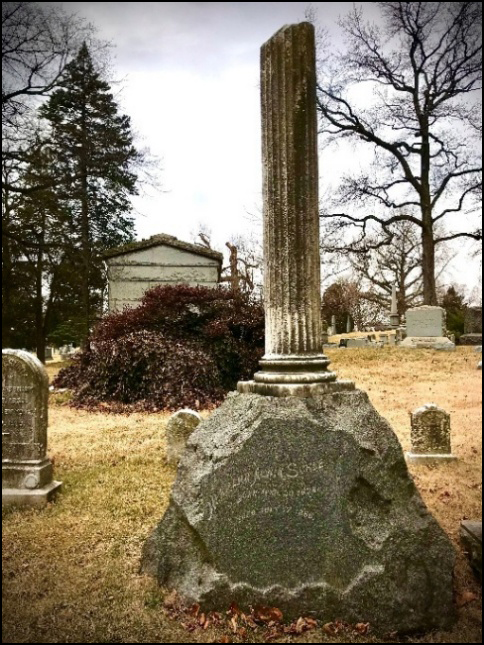 register, which when translated from German to English means merchant. Unfortunately, Herman died a little over a
year later in 1866 at age 38 and was buried at the Greenwood Cemetery in
Brooklyn, New York. When his estate was
probated that year his two eldest sons, Herman and
Fredrick (also known as Fritz as seen in the picture here on the left[38])),
were listed as living in Düren, Germany whereas his other four children were
living in the Flushing section of Queens, New York. His wife remained in the New York City area
although she traveled to Bonn, Germany where she stayed for a few years from
1890 until 1893. She died in 1898, 32
years after her husband’s death, either at College Point in Queens, New York or
in Bonn, Germany. When her estate was
originally probated her children: Herman, Frederick, Iwan and Julia, each
received $4,896 (approximately equal to $177,925[39]). Additional court records related to Malwine’s estate were recorded in 1903 and 1905 and they
listed the eldest son Herman as living in Flushing, New York, whereas the other
three children had returned to Germany with Julia living in Stolberg, Frederick
in Düren and Iwan in Cologne.
register, which when translated from German to English means merchant. Unfortunately, Herman died a little over a
year later in 1866 at age 38 and was buried at the Greenwood Cemetery in
Brooklyn, New York. When his estate was
probated that year his two eldest sons, Herman and
Fredrick (also known as Fritz as seen in the picture here on the left[38])),
were listed as living in Düren, Germany whereas his other four children were
living in the Flushing section of Queens, New York. His wife remained in the New York City area
although she traveled to Bonn, Germany where she stayed for a few years from
1890 until 1893. She died in 1898, 32
years after her husband’s death, either at College Point in Queens, New York or
in Bonn, Germany. When her estate was
originally probated her children: Herman, Frederick, Iwan and Julia, each
received $4,896 (approximately equal to $177,925[39]). Additional court records related to Malwine’s estate were recorded in 1903 and 1905 and they
listed the eldest son Herman as living in Flushing, New York, whereas the other
three children had returned to Germany with Julia living in Stolberg, Frederick
in Düren and Iwan in Cologne.
The
youngest son of Carl and Carolina Schleicher, Richard Rudolph Schleicher[40]
(pictured here) was born in 1843 in Düren.
By 1864 he was working for his father as a needle manufacturer when he
traveled to the UK and registered a patent for a needle grinding machine. While in the UK he resided in Redditch for a period of time. In
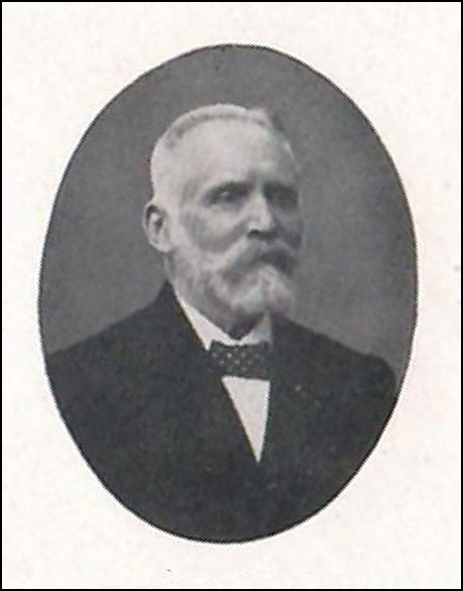 1869[41]
Richard built a villa near the Schönthal factory for his future family,
which became known as Villa Schleicher, and he also purchased the park near his
home which included the Karlsburg Castle.
Because he was only 26 years old in 1869, was not married and his father
Carl was in a much better financial position, it seems most likely that his
father financed most of this. In 1879
Richard married Amalie Reuter in Rüdesheim am Rhine and after they returned to
the Schönthal
area they had at least 3 children: Waldemar who was born c1881, Edith and
Lulu. To honor his children, Richard had
a tower for each one built in the park near the Karlsburg Castle[42]
of which two still exist to this day.
Richard took over his father’s needle manufacturing business in 1883
after his father died and continued working there until 1899 when he decided to
focus his attention on his other landed assets.
In 1893[43] Richard
purchased the manor estate known as Burg Holzhelm which was located just west
of the neighboring village of Heistern.
Richard died in at his home in Schönthal in 1918.
1869[41]
Richard built a villa near the Schönthal factory for his future family,
which became known as Villa Schleicher, and he also purchased the park near his
home which included the Karlsburg Castle.
Because he was only 26 years old in 1869, was not married and his father
Carl was in a much better financial position, it seems most likely that his
father financed most of this. In 1879
Richard married Amalie Reuter in Rüdesheim am Rhine and after they returned to
the Schönthal
area they had at least 3 children: Waldemar who was born c1881, Edith and
Lulu. To honor his children, Richard had
a tower for each one built in the park near the Karlsburg Castle[42]
of which two still exist to this day.
Richard took over his father’s needle manufacturing business in 1883
after his father died and continued working there until 1899 when he decided to
focus his attention on his other landed assets.
In 1893[43] Richard
purchased the manor estate known as Burg Holzhelm which was located just west
of the neighboring village of Heistern.
Richard died in at his home in Schönthal in 1918.
Charles Schleicher - Belle Vallee
(aka Carl Schleicher & Söhne): Images
UK Letters Patent
No 982 dated September 20, 1858

Drawing of the
machinery for pointing needles, pins, &c. (S=English Patents of
Inventions, Specifications: 1858,
974-1038, 1858 from books.google.com).
UK Letters Patent No 982 dated September
20, 1858

Additional
drawings of the machinery for pointing needles, pins, &c. (S=English
Patents of Inventions, Specifications:
1858, 974-1038, 1858 from books.google.com).
UK Provisional
Patent No 2224, September 12, 1864
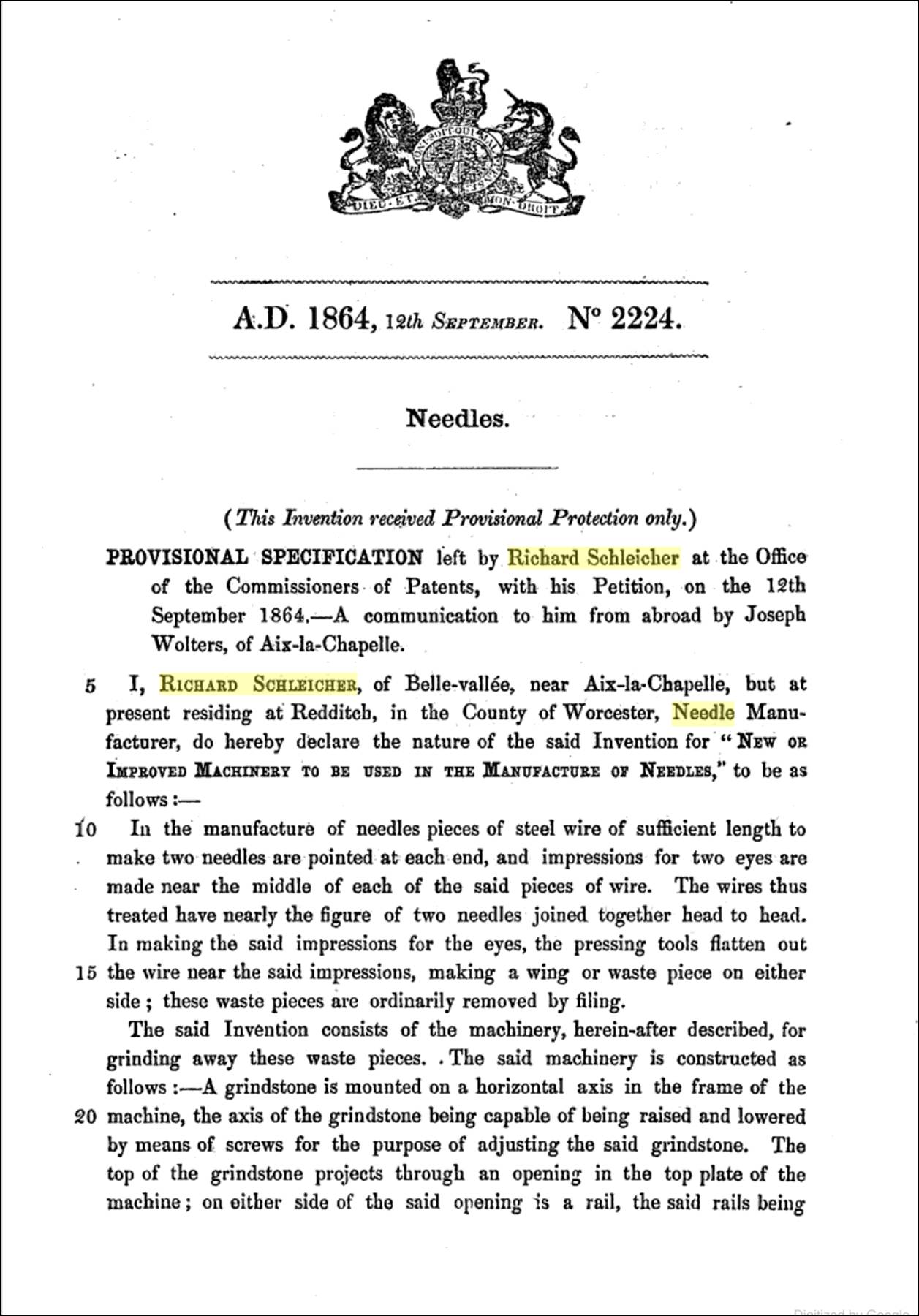
Page
1 (S=English Patents of Inventions, Specifications: 1864, 2174-2236, 1865 from
books.google.com).
UK Provisional Patent No 2224, September
12, 1864
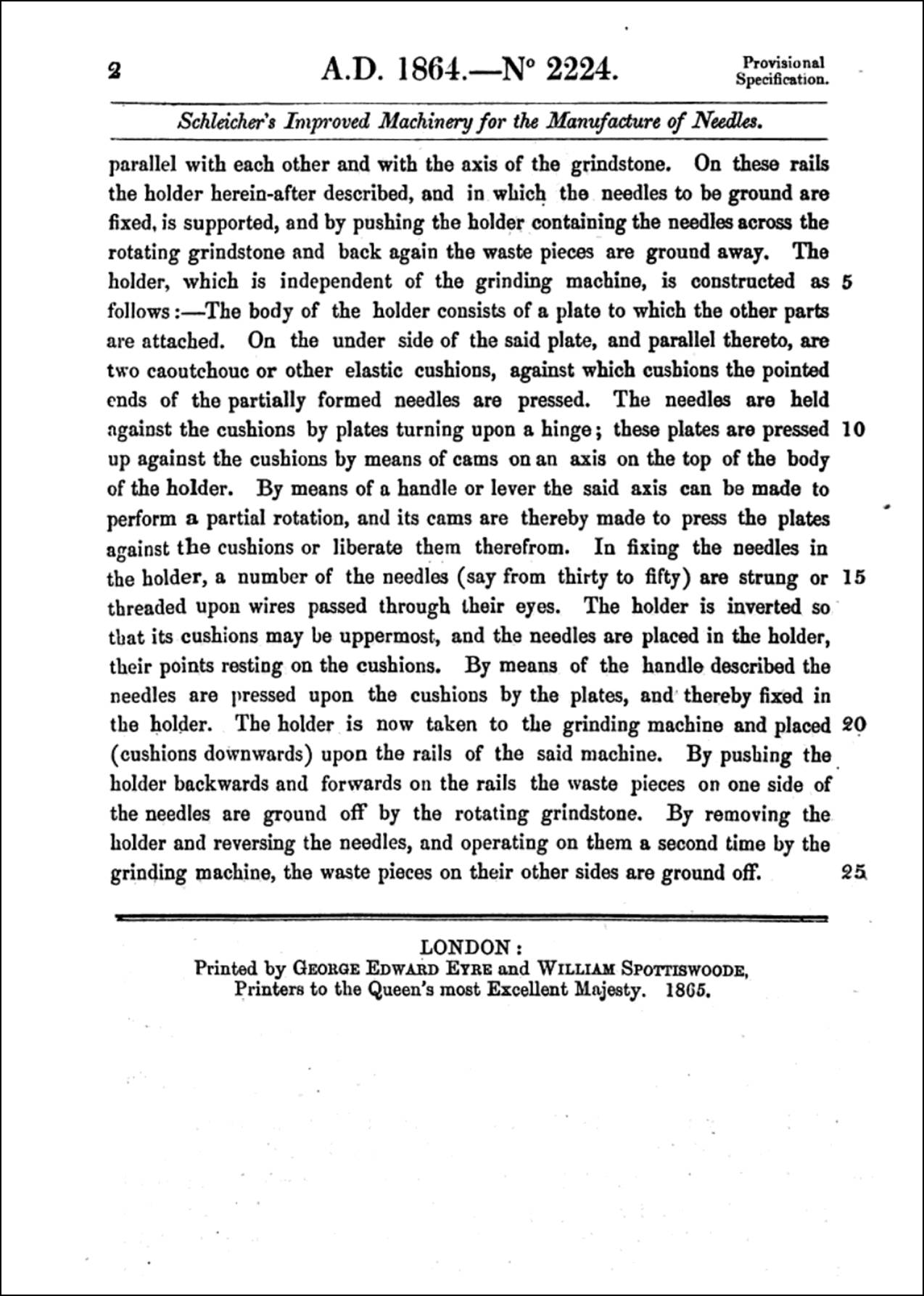
Page
2 (S=English Patents of Inventions, Specifications: 1864, 2174-2236, 1865 (from
books.google.com).
US Patent No.
115,529, May 30, 1871
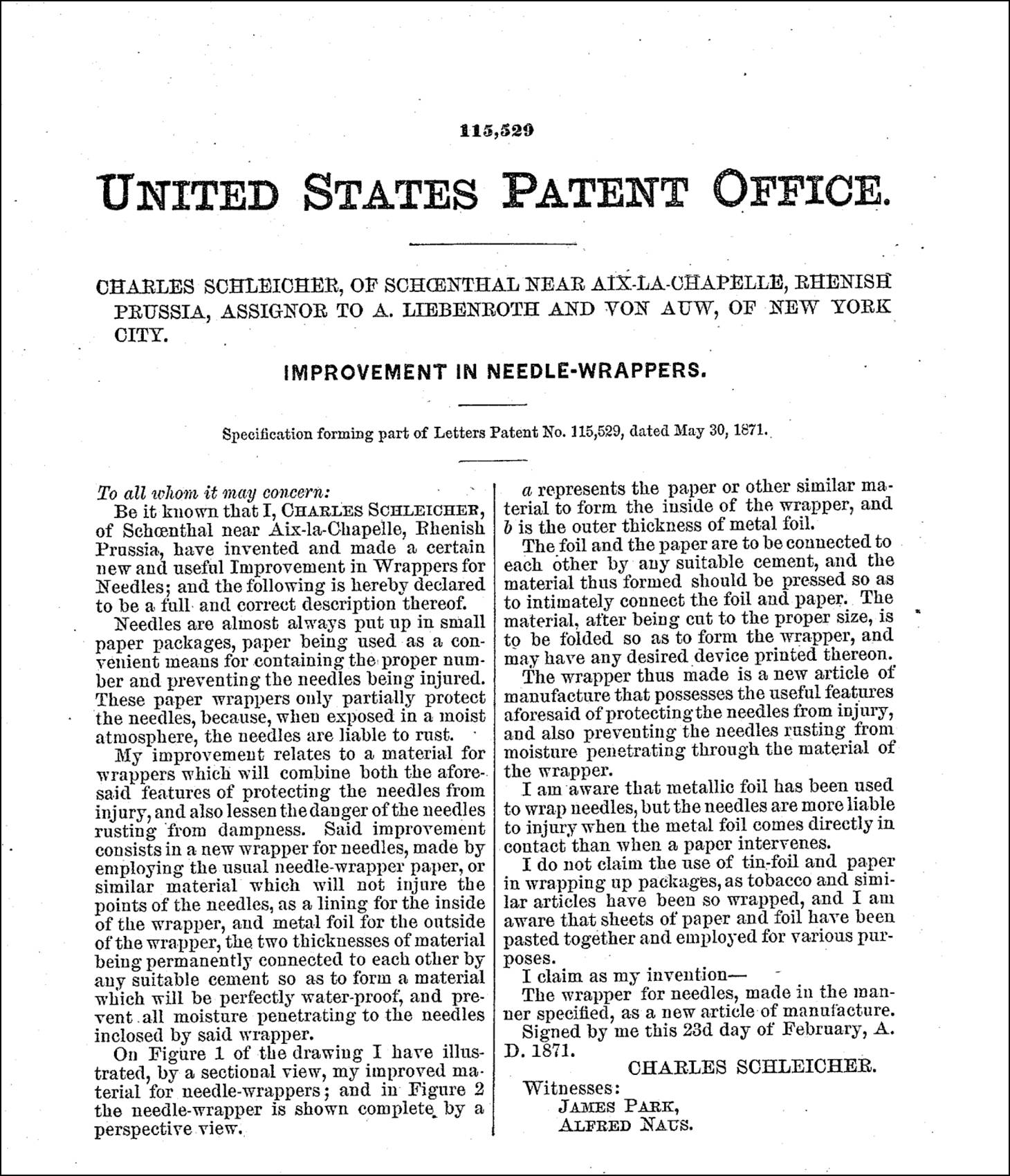
(S=https://patentimages.storage.googleapis.com).
Schönthal and Neighboring Areas
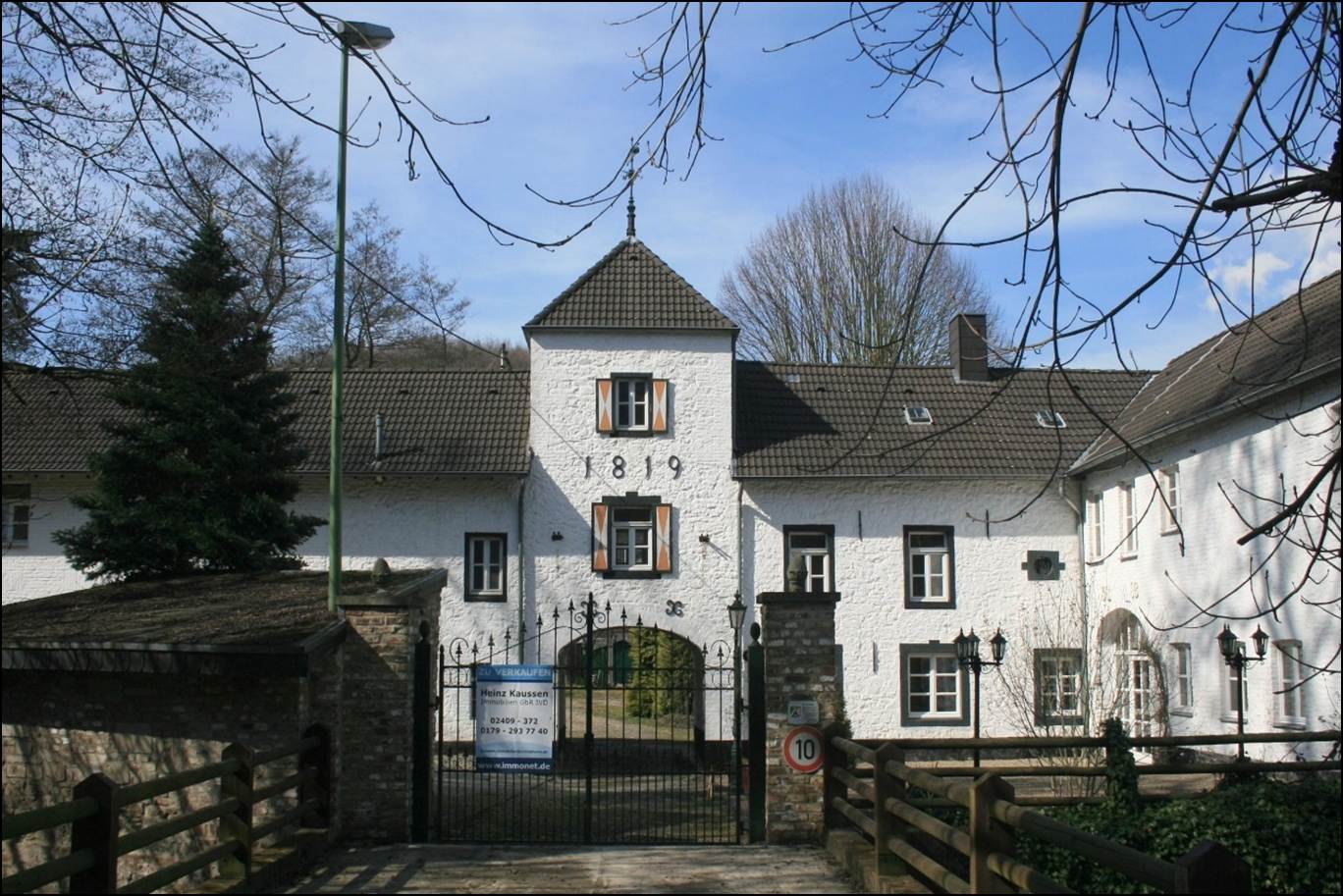
View of the southeast side of Schönthal from Wikipedia: Schönthal
(Langerwehe).
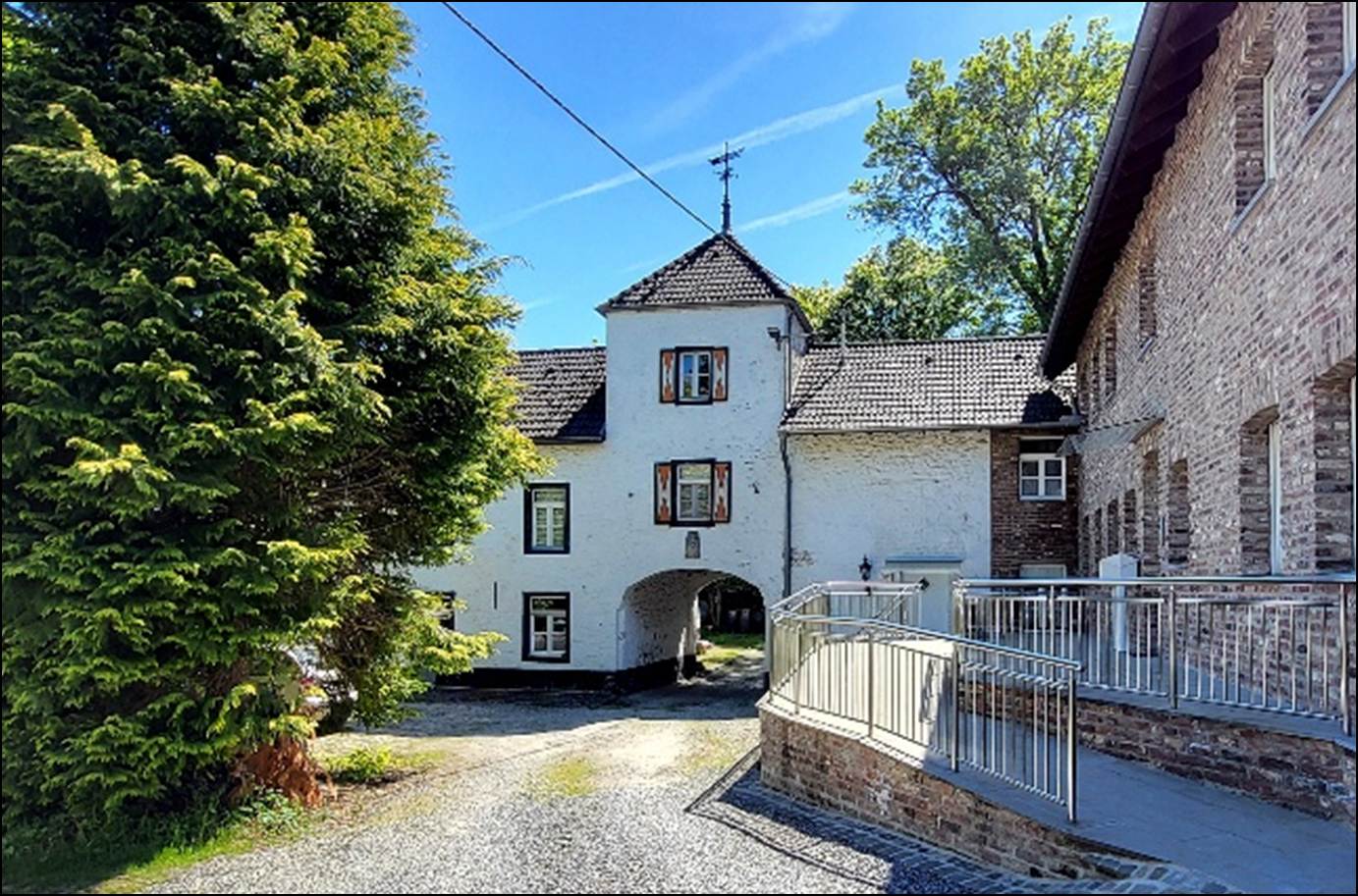
View of the
northwest side of the Schönthal factory building, 2025.
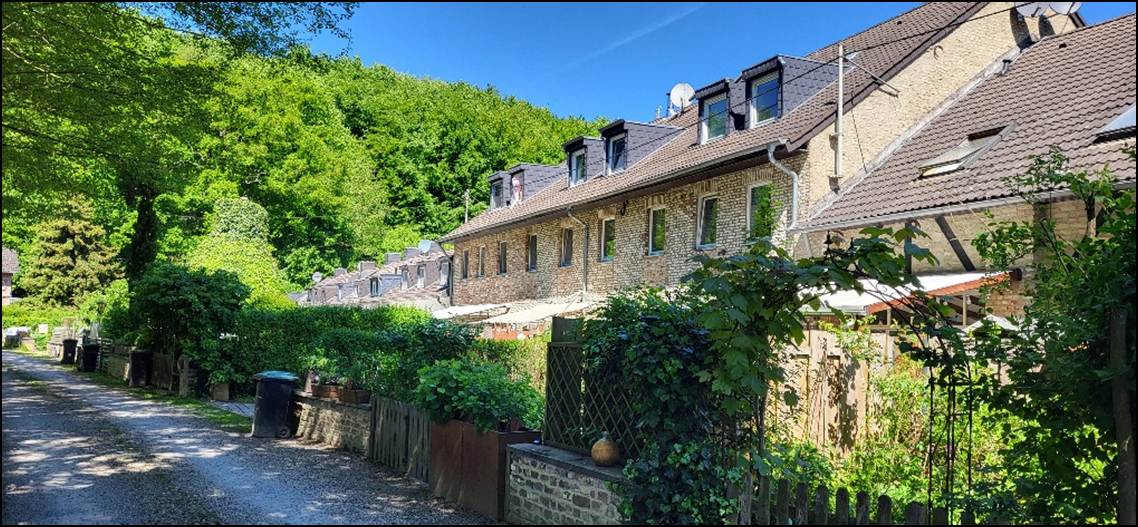
View of some of
the buildings northwest of the Schönthal factory, 2025.
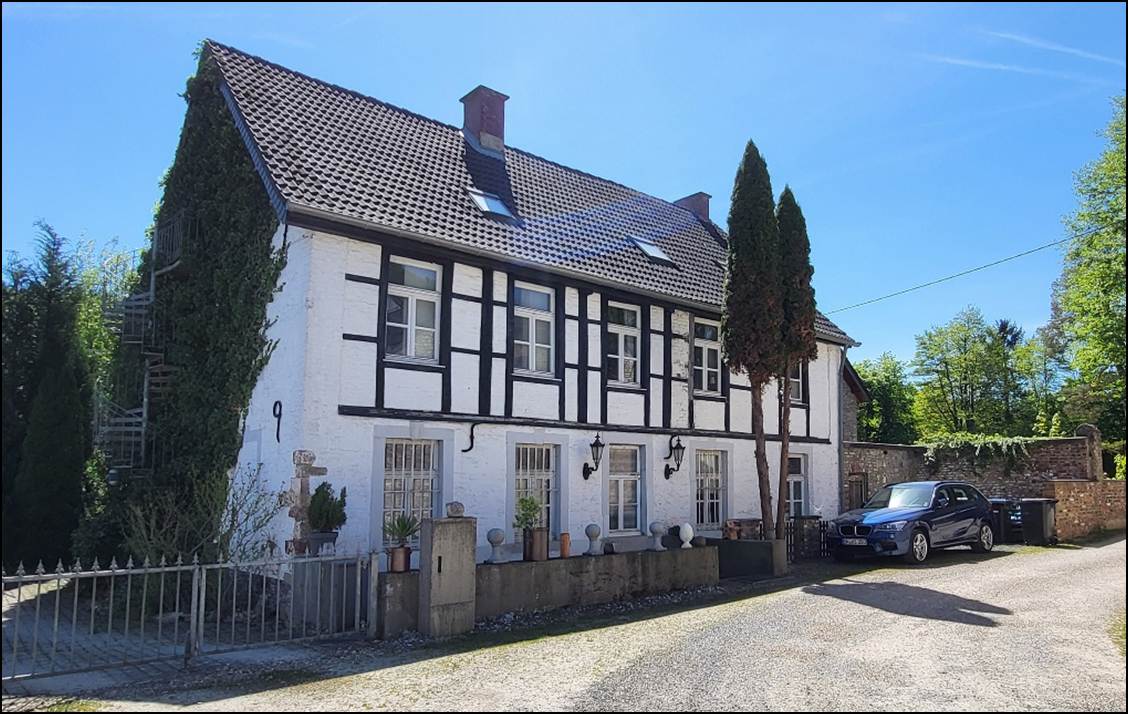
The building north
of the Schönthal factory where the Carl Schleicher family originally
lived, 2025.
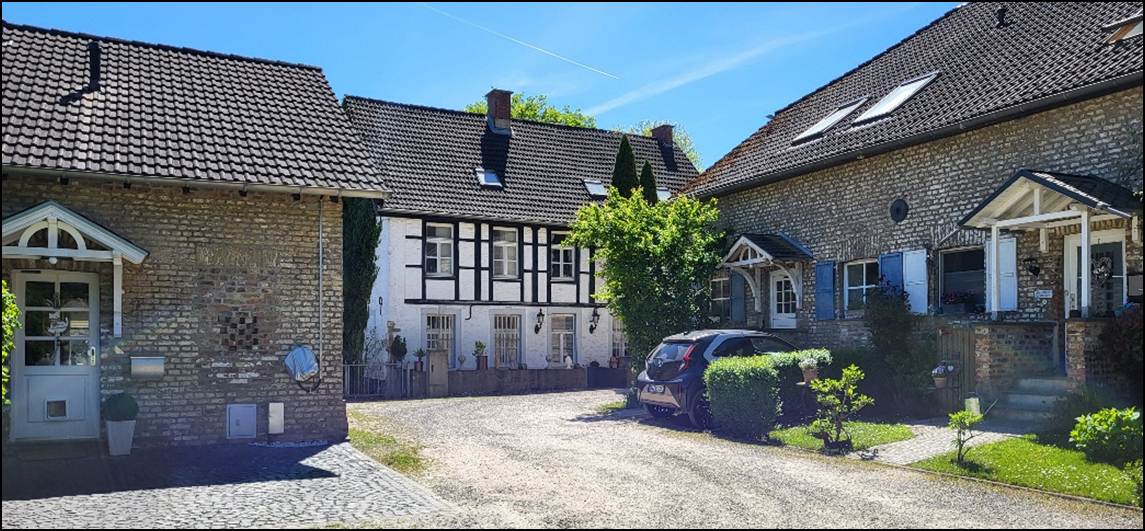
View of the
buildings next to Carl Schleicher’s house which is in the center, 2025.
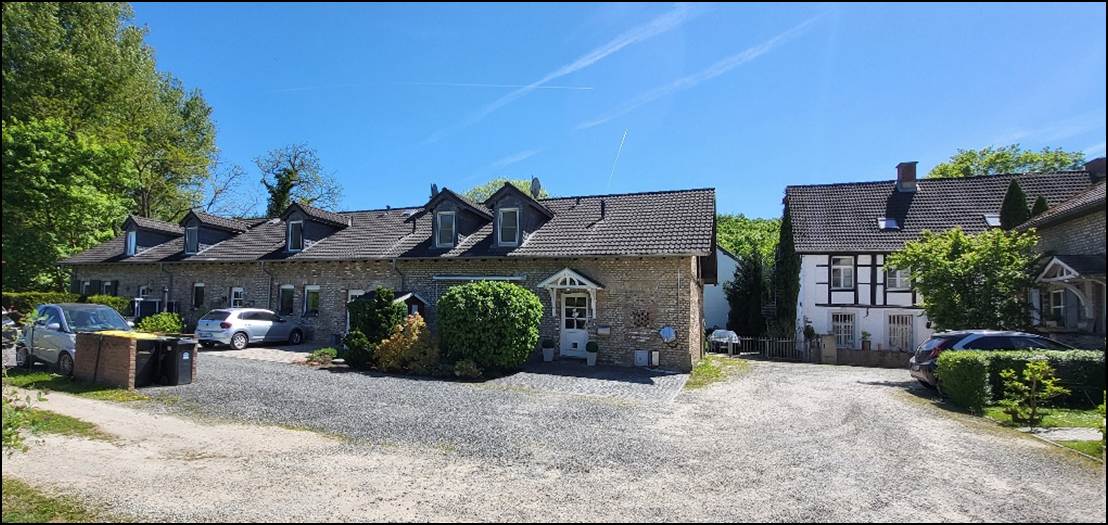
View of the buildings northwest of the Schönthal factory, 2025.
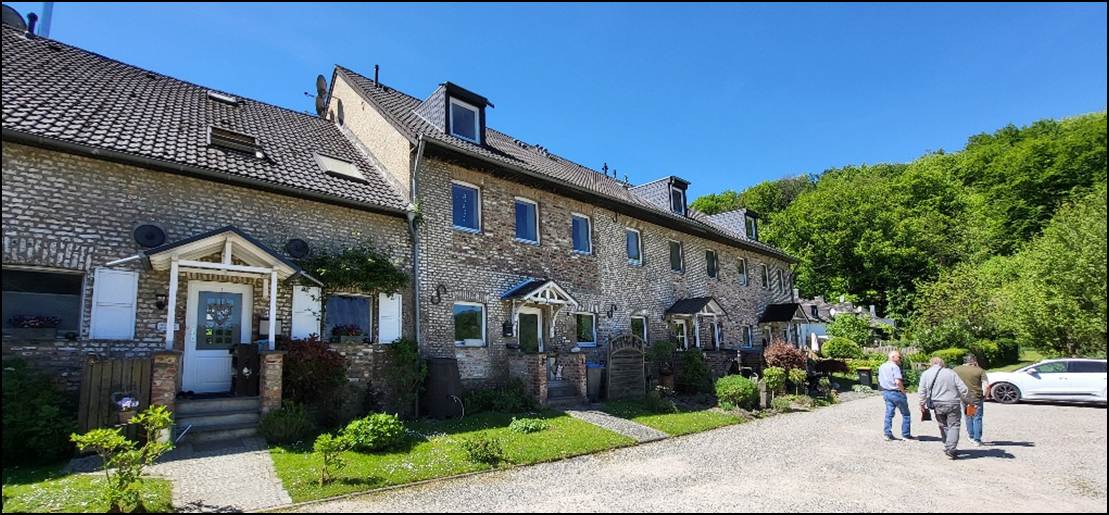
Views of other
buildings northwest of the Schönthal factory. 2025.
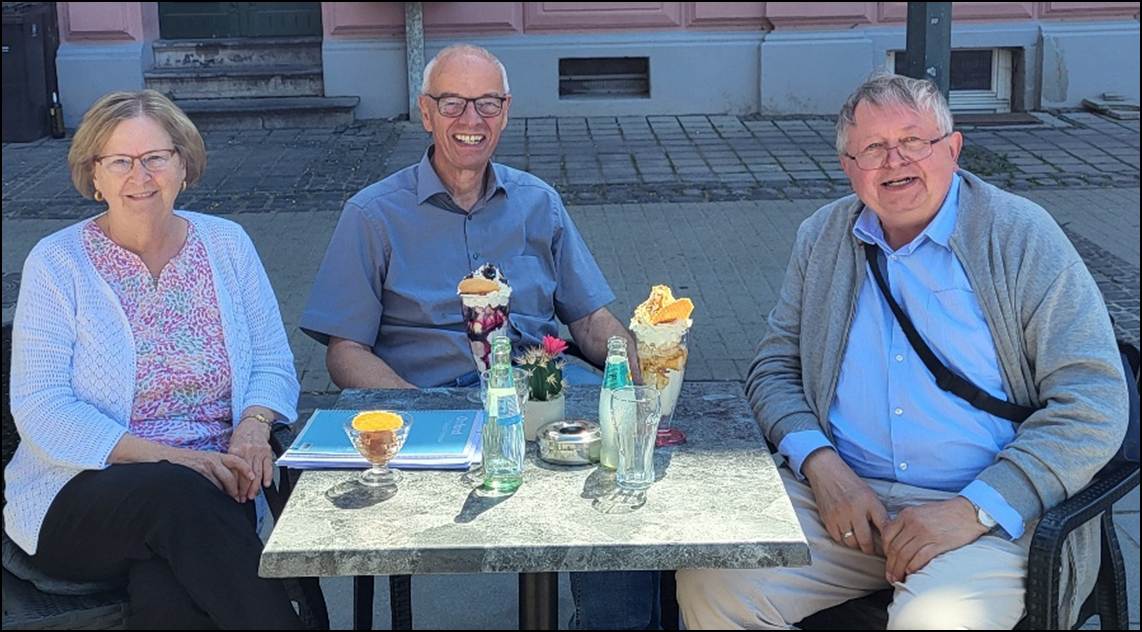
Left to right: Terry
Meinke, Richard Simons and Klaus Schleicher enjoying ice cream in Stolberg
after visiting the Museum Zinkhütter Hof, 2025. A special thank you goes to Richard for
obtaining approval to visit all of these places in the
Langerwehe and Stolberg area and to Klaus for joining us on our visits and for
sharing information about his Schleicher ancestors.
Three views of the
Bendenmühle
factory area in Langerwehe where the Schleicher business moved to in 1899,
2025. These three photographs were
provided by Klaus Schleicher.
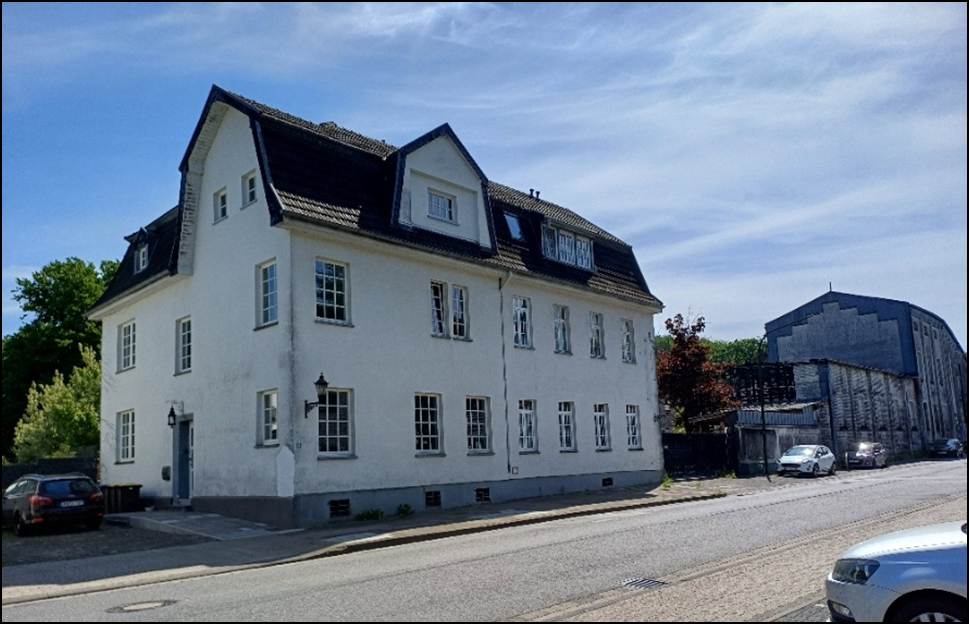
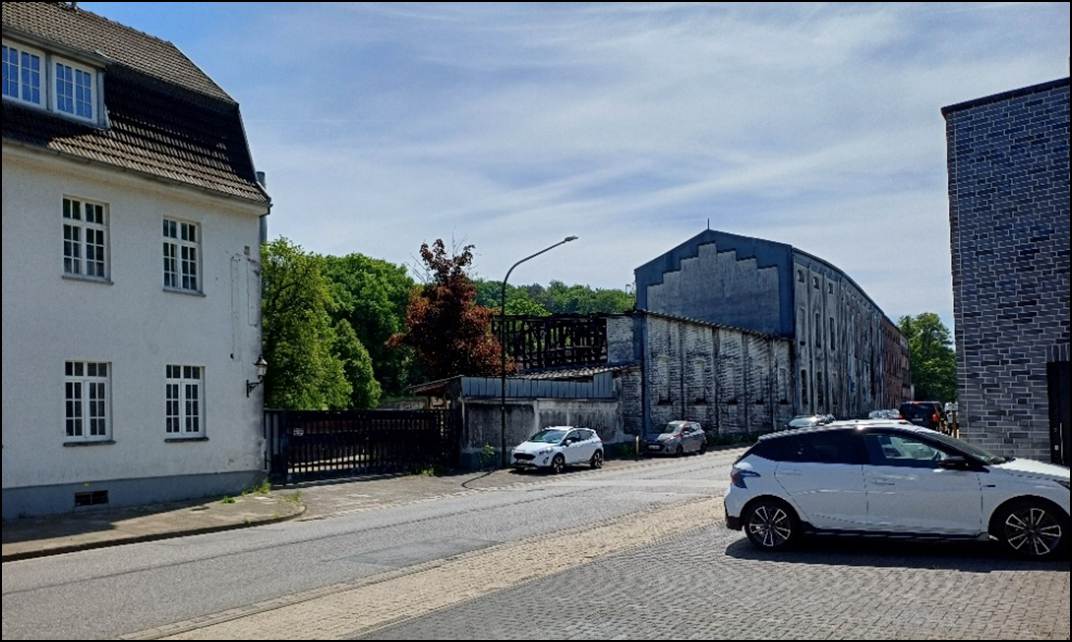


Painting of the
Schönthal
factory, owned by Richard Simons of Langerwehe.
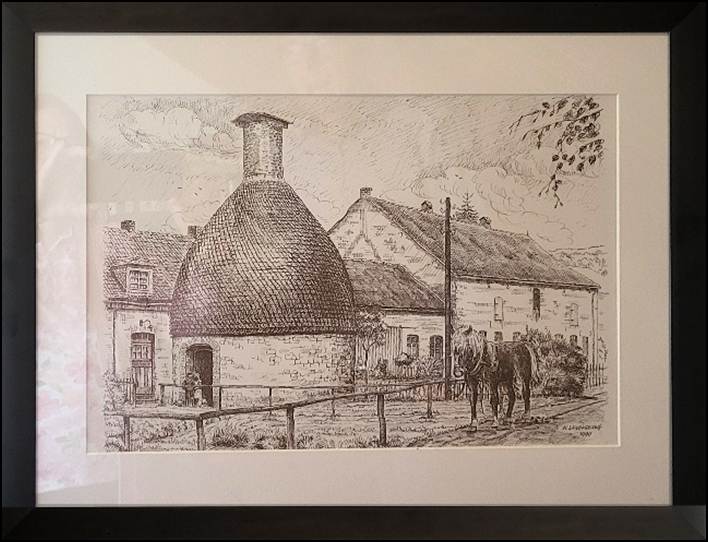
Drawing
of the annealing furnace which was used to heat the needle
points and then cool them to harden them which was located near the Schönthal
factory, owned by Richard Simons of Langerwehe.
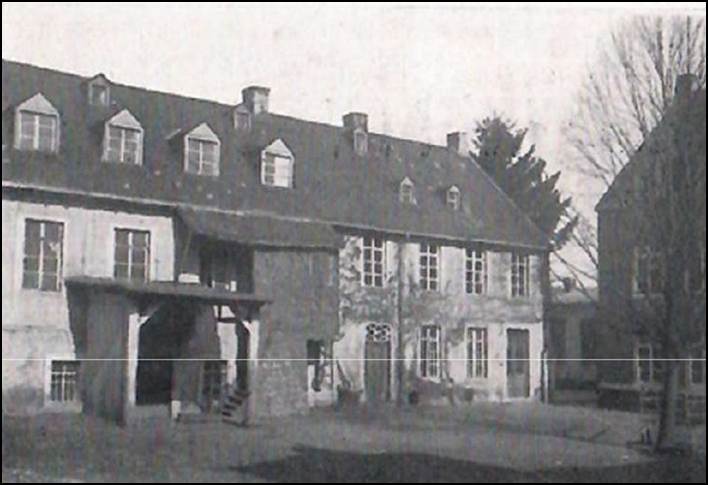
Photograph
of the Schleicher family house entranceway next to the Schönthal
factory from the 1919 100th anniversary book.

Photograph
of the Schönthal factory from the 1919 100th anniversary
book.

View
of the former annealing furnace near the Schönthal factory, 2025,
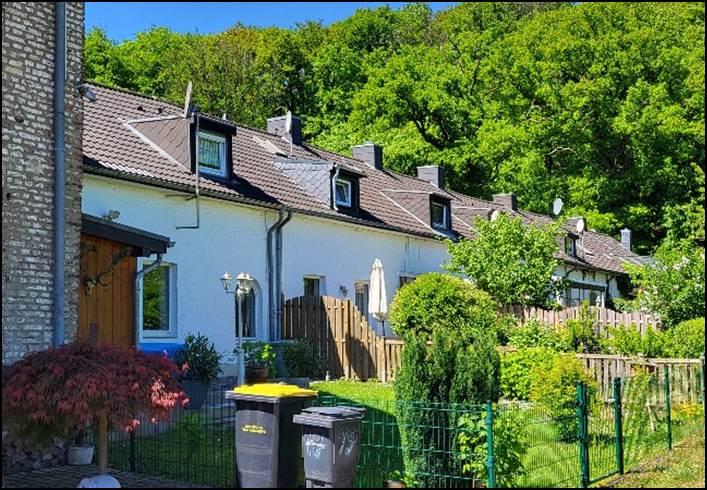
View
of the other houses next to the Schönthal factory where the workers once
lived, 2025.
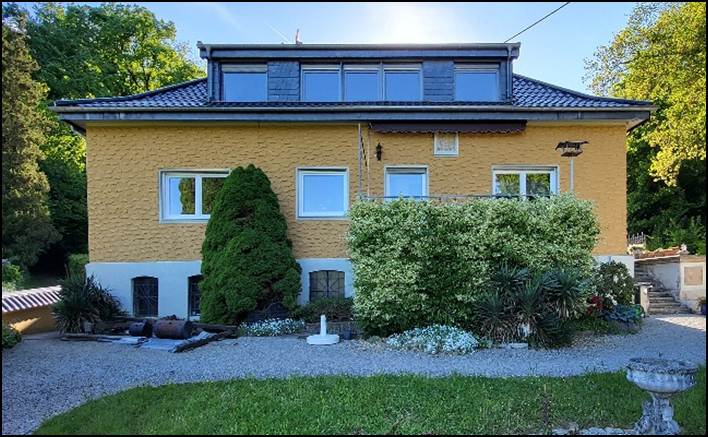
The
Villa Schleicher house near the Schönthal factory, 2025.

Burg Holzheim gate, 2025.
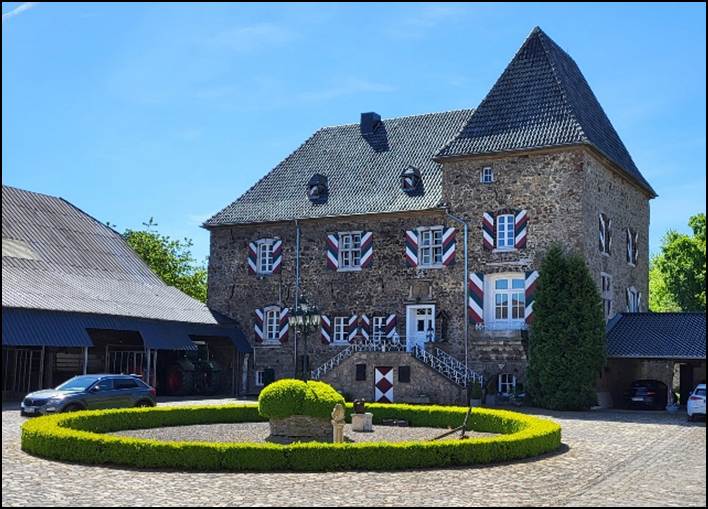
Burg Holzheim
Manor House, 2015.
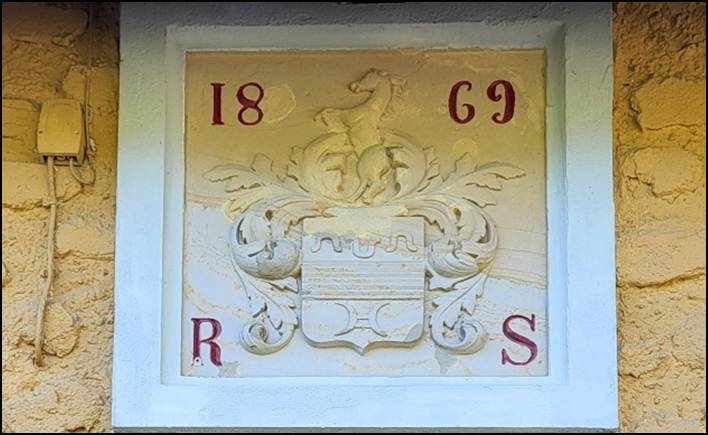
Plaque
over the doorway at the Villa Schleicher house near the Schönthal
factory, 2025.
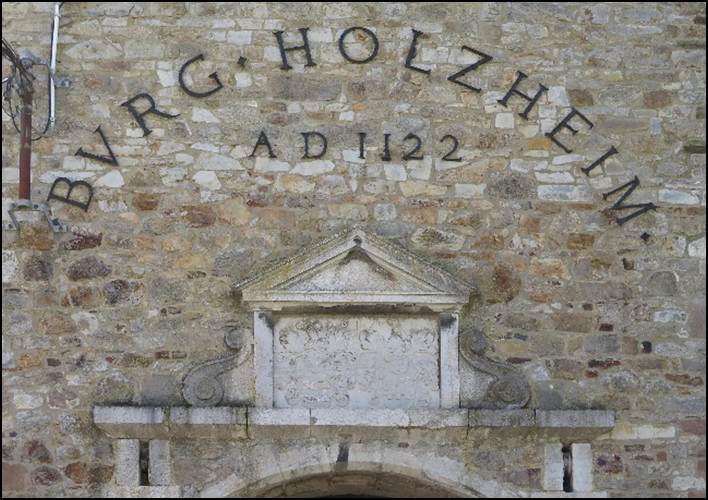
Plaque
above the Burg Holzheim gate, 2025.

Plaque
over the entrance to the Burg Holzheim Manor House, 2015.
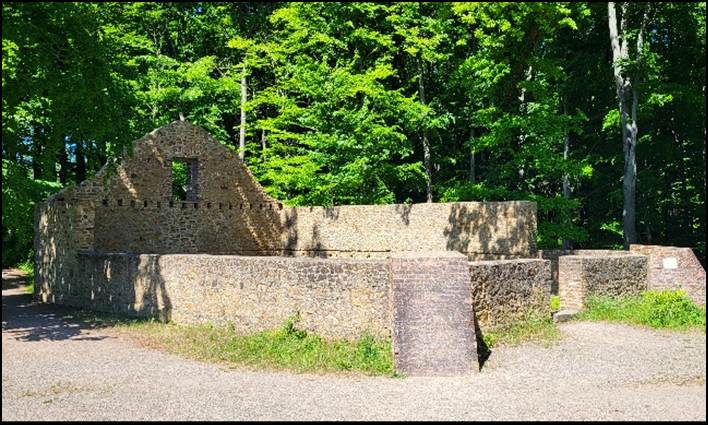
Ruins of Karlsburg
Castle, 2025.
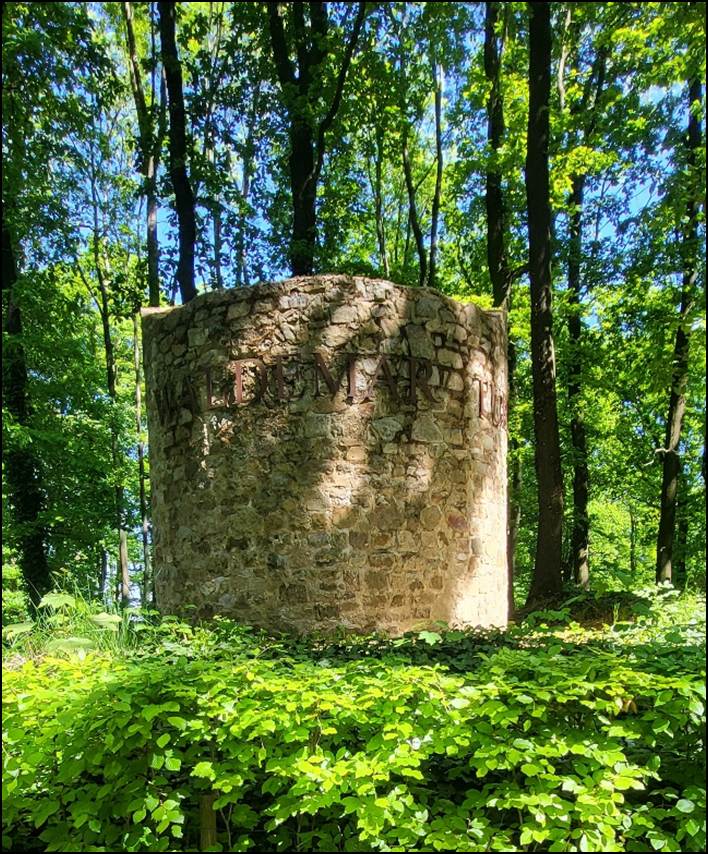
The
Waldemar Tower in Karlsburg Park, 2025.
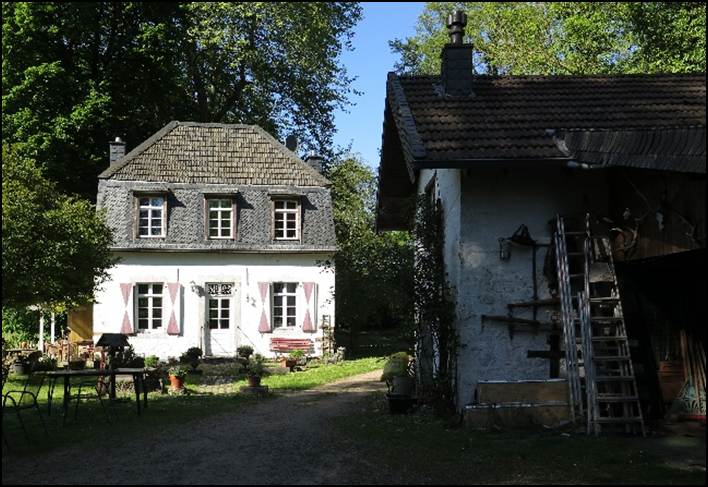
Klein
Schönthal,
2025.
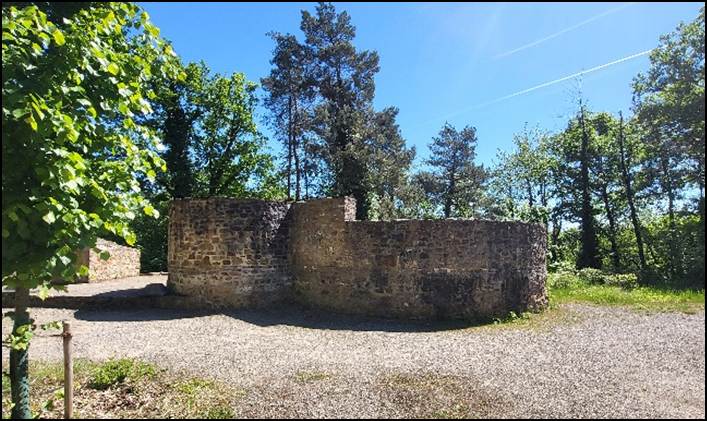
Additional
ruins of Karlsburg Castle, 2025.

The Lulu Tower in
Karlsburg Park, 2025.
Scotland Street in
Birmingham, UK
In
1861 Charles Schleicher was listed in a Birmingham city directory as a
manufacturer of needle pointing machines at the Borough saw mills on Scotland
Street. Scotland Street is a short one
block long street located next to a Birmingham canal making it easy to
transport merchandise from one place to another during the Victorian Period. This is what the area looks like today
however, all of the buildings are modern except one
which had modern floors added much later.

View
of Scotland Street from the west side, 2025.
The old building being the second one on the left.
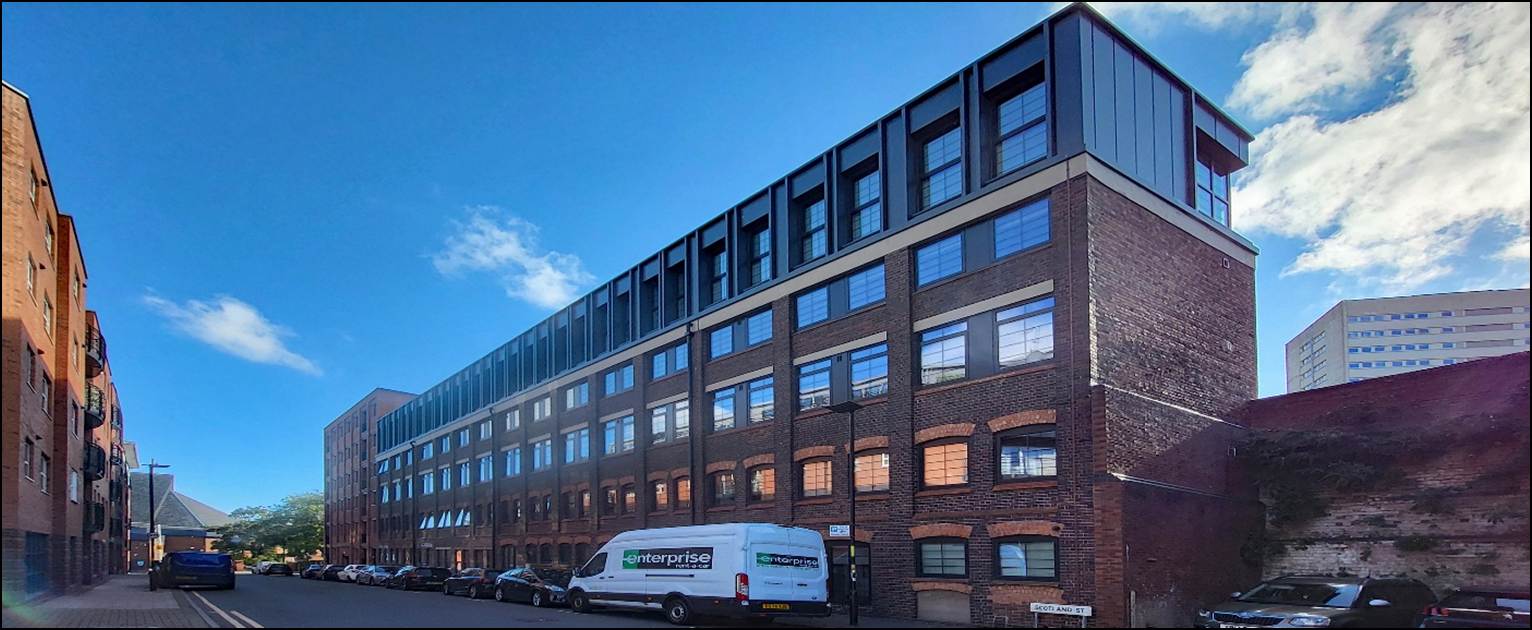
View
of Scotland Street from the east side, 2025.
The first two floors appear to be from an earlier date because of their
style and the third, fourth and fifth floors were most likely added much later.

Closer view of the oldest building on
Scotland Street from the west side, 2025.
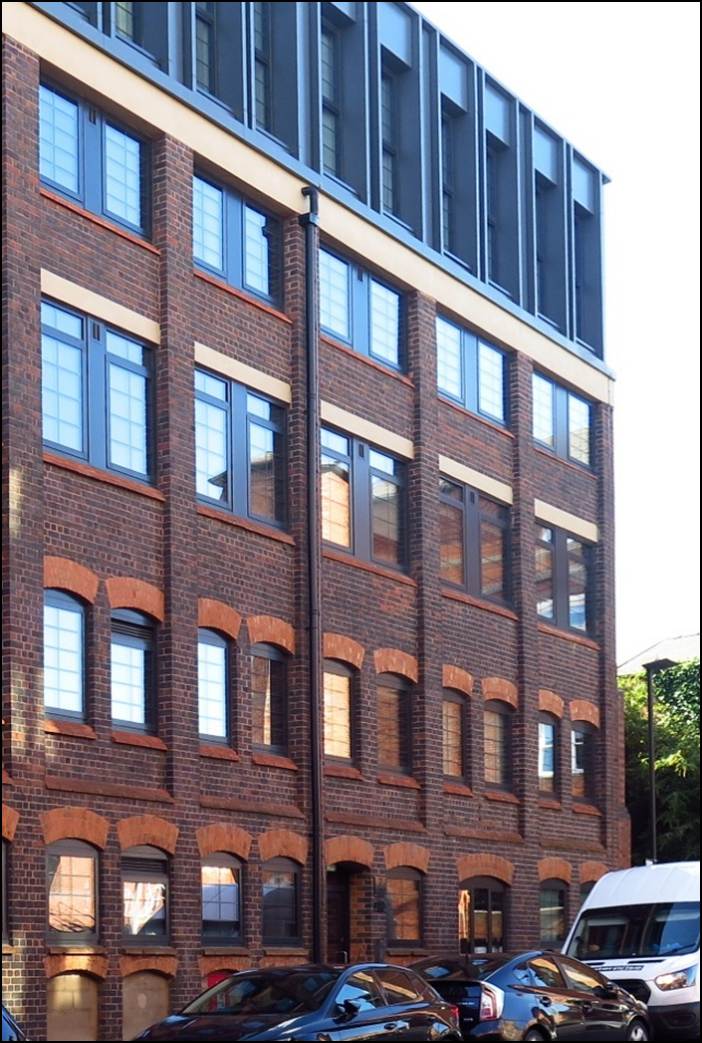
Close up showing
the difference between the windows on the first two floors and the top three
floors, 2025.
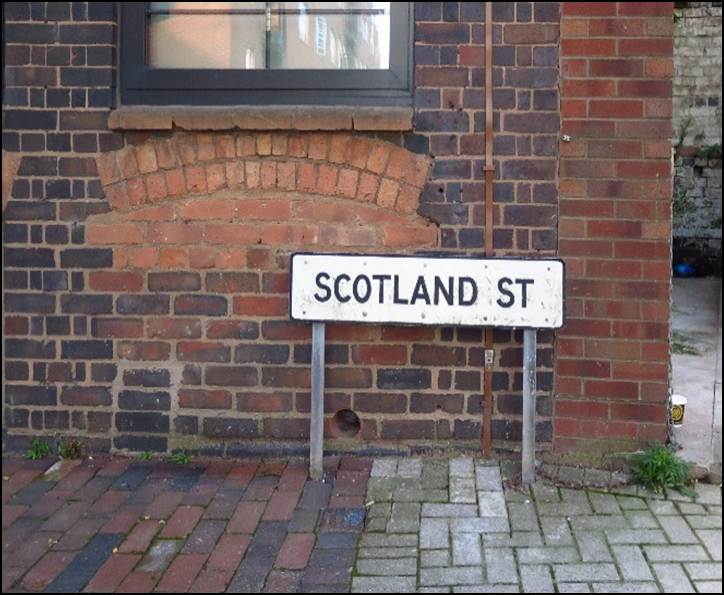
Street
sign at the east side of the building, 2025.
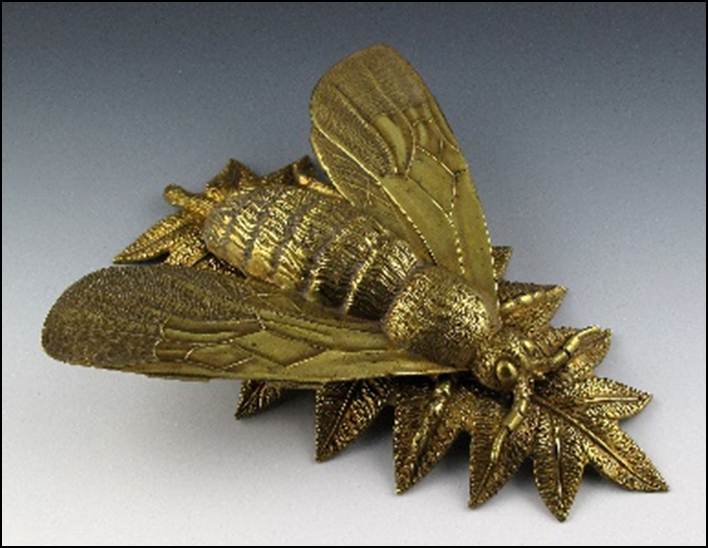
The Bee needle
case.
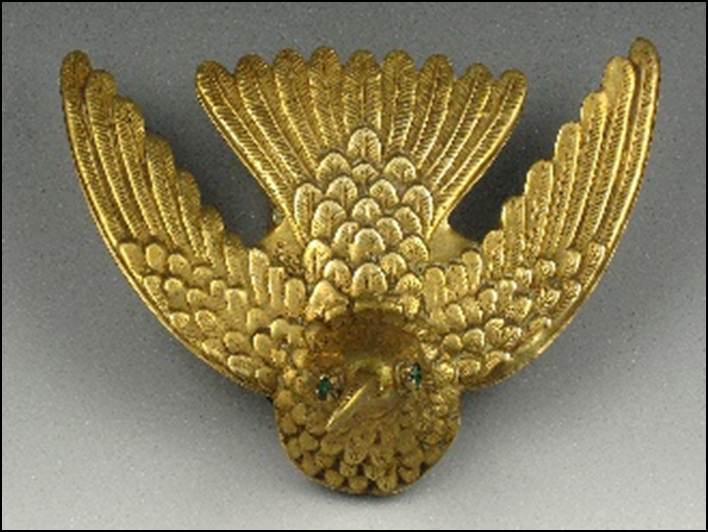
The Bird on a Box
needle case.
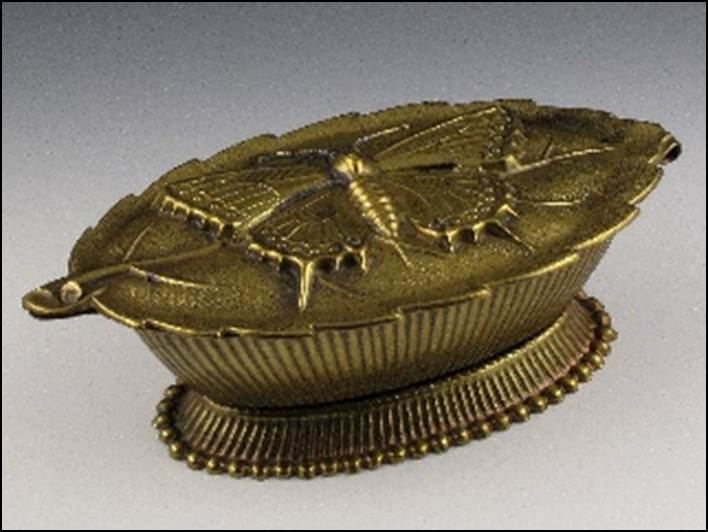
The Butterfly
Box-Oval Tub needle case.
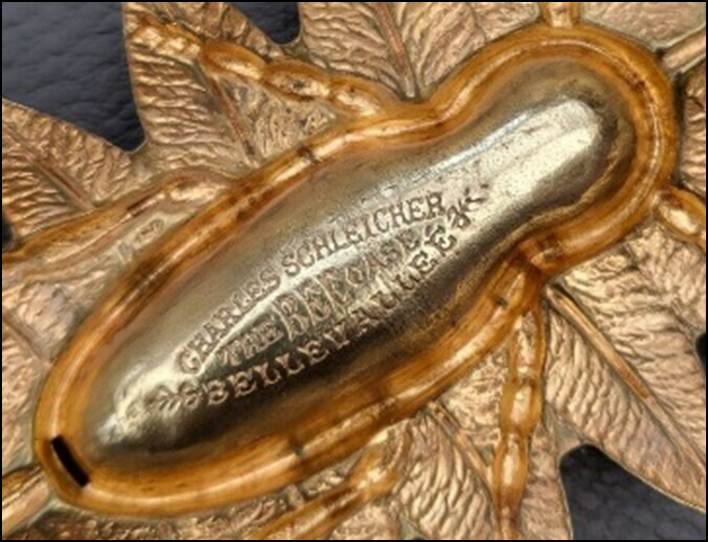
Bottom
with the Charles Schleicher name (S=eBay).
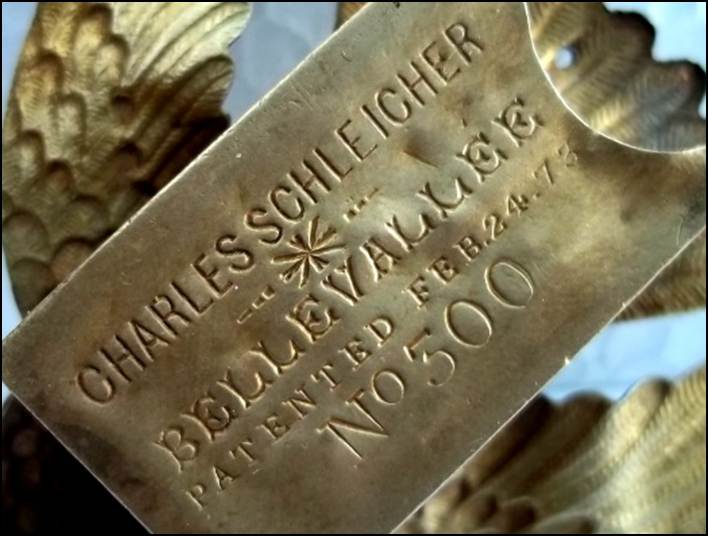
Bottom
with the Charles Schleicher name.

Bottom
with the Charles Schleicher name (S=Margie Harris).

Quadruple Golden
Casket - Fleur-de-Lis.
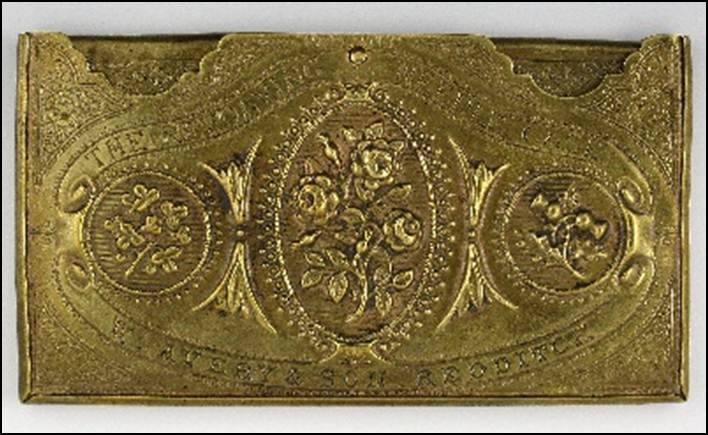
The Revolving
needle case.
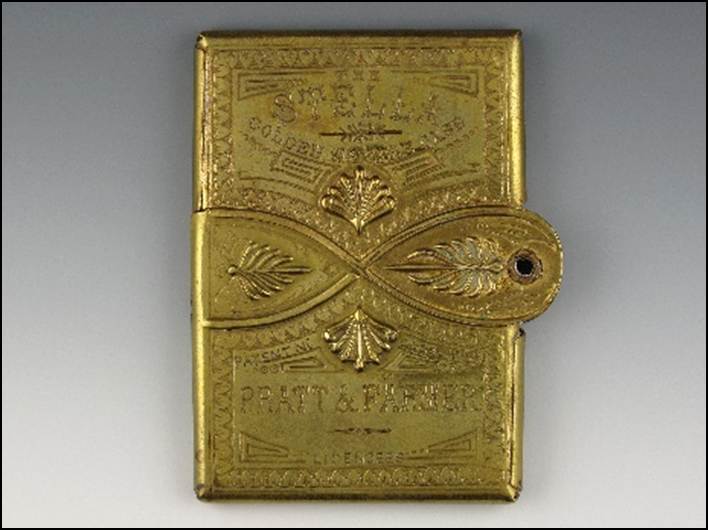
The Stella needle
case.

Detail with the
Charles Schleicher name.

Detail
with the Charles Schleicher name (S=eBay).

Detail
with the Charles Schleicher name (S=Elaine Barnard-Brown).
Charles
Schleicher - Belle Vallee (aka Carl Schleicher & Söhne):
Genealogy
(Note:
most of the genealogical material presented here comes from ancestry.com, My
Heritage and Family Search websites. Items
marked with an * are listed in multiple family trees with these names and dates. Unfortunately, not many source records were
found proving these names, dates and who their parents were. As a result, detailed research of all family
members was not undertaken. The main focus here was on Matthias Leonhard Schleicher, Carl
Viktor Schleicher, Herman Alwin Schleicher and Richard
Rudolph Schleicher. Also, if a child was
only listed in one place without source documentation, they were not included.)
Generation
1: Matthias Leonhard Schleicher
(1758-1836) and Maria Apollonia Hoesch (c1765/66-1842)
· Born: September 19, 1758* Stolberg with parents
Matthais Schleicher (1726-1799)* and Anna Maria Mewis
(1721-1791)*.
· Marriage: May 10,
1786* Schneidhausen, Duren, married Maria Apollonia
Hoesch who was born in 1765/66* in Düren whose parents were Hugo Ludolf
Hoesch (1727-1790)* and Anna Catharina Deutgen (1735-1789)*
· Occupation: copper
master, brass and needle manufacturer.
· Death: October 7,
1836* Stolberg.
· Wife’s Death: June
25, 1842* Stolberg.
· Children:
1.
Matthias
Ludolph Schleicher (1788-1831)*.
2.
Johann
Leonhard Schleicher (1791-1825)*. Marriage: June 25,
1816 Stolberg (S=Germany, Select Marriages, 1558-1929 available at
ancestry.com), listed as Johann Leonard Schleicher age 25 born in 1791 in
Stolberg whose parents were Matthias Leonard Schleicher and Maria Apollonia Hoesch
with his spouse Cornelia Julianna Von Asten.
3.
Stanislaus
August Schleicher (1792-1865)*.
4.
Juliana
Schleicher (1793-1868)*. Marriage: September 35, 1813 Stolberg
(S=Germany, Select Marriages, 1558-1929 available at ancestry.com), listed as Julie
Schleicher age 19 born in 1794 in Stolberg whose parents were Matthias Leonard
Schleicher and Maria Apolonie Hoesch with her spouse Ludolphe
Mattias Hosch.
5.
Johanna
Schleicher (1795-1854)*. Marriage: May 9, 1817 Stolberg (S=Germany,
Select Marriages, 1558-1929 available at ancestry.com), listed as Johanna
Schleicher age 21 born in 1796 in Stolberg whose parents were Matthias Leonard
Schleicher and Maria Apollonia Hoesch with her spouse Wilhelm Leonard Schull.
6.
Anna
Sybilla Schleicher (1796-1867)*. Marriage: October 2, 1820 Stolberg
(S=Germany, Select Marriages, 1558-1929 available at ancestry.com), listed as
Anna Sybilla Schleicher age 24 born in 1796 in Stolberg whose parents were
Matthias Leonard Schleicher and Maria Apollonia Hoesch with her spouse Johann
Edmund Lynen.
7.
Sara
Sophia Schleicher (1799-1835). Born:
September 19, 1799 Stolberg (S=Germany, Select Births and Baptisms, 1558-1898
available at ancestry.com), listed as Sara Sophia Schleicher with parents
Mathias Leonard Schleicher and Maria Appollonia Hoesch.
8.
Napoleon
Jeremias Schleicher (1801-1875). Born:
August 2, 1801 Stolberg (S=Germany, Select Births and Baptisms, 1558-1898
available at ancestry.com), listed as Napoleon Jeremias Schleicher with parents
Mathias Leonard Schleicher and Maria Apolonia Hoesch.
9.
Carl
Viktor Schleicher (1803-1883)*. See Generation 2.
10.
Marie
Apolonie Schleicher (1808-??/1823).
Born: June 18, 1808 Stolberg (S=Germany, Select Births and Baptisms,
1558-1898 available at ancestry.com), listed as Marie Apolonie Schleicher with
parents Matthias Leonard Schleicher and Marie Apolonia Hoesch).
11.
Hugues
(aka Hugo) Schleicher (1809-1855). Born:
December 24, 1809 Stolberg (S=Germany, Select Births and Baptisms, 1558-1898
available at ancestry.com), listed as Hugues Schleicher with parents Matthias
Leonard Schleicher and Marie Appollie Hoesch.
12.
Adolphe
Schleicher (1811-??/1812). Born: June
23, 1811 Stolberg (S=Germany, Select Births and Baptisms, 1558-1898 available
at ancestry.com), listed as Adolphe Schleicher with parents Matthias Leonard
Schleicher and Marie Appollonia Hoesch.
Generation
2: Carl Viktor Schleicher (1803-1883)
and Carolina Wilhelmina von Auw (1807-1883)
· Born: February 6,
1803* Stolberg (S=Germany, Select Births and Baptisms, 1558-1898 available at
ancestry.com), listed as Carl Victor Schleicher with parents Mathias Leonard
Schleicher and Maria Apollonia Hoesch.
Also listed in various records as Karl Viktor Schleicher or Carl Viktor
Schleicher.
· Marriage: July 1,
1826*, married Carolina Wilhelmina von Auw who was
born in 1807* in Düren whose parents were Johann Abraham von Auw (1766-1820)* and Anna
Catharina Schleicher (1773-1824)*. Also listed in various records as Karolina.
· Occupation: needle
manufacturer, paper manufacturer and commercial
council member.
· Wife’s Death: April 18, 1883* Düren.
· Death: August 3,
1883* Düren.
· Obituary: Hermanner Volksblatt newpaper dated
September 7, 1883, page 3, column 2 (S=www.newspapers.com).
· Children:
1.
Hugo
Schleicher (1827-1895*). See Generation
3.
2.
Herman
Alwin Schleicher (1828-1866)*. See Generation 3. Also listed in some records as Alwin
Schleicher.
3.
Matthias
Leonhard Schleicher (1830-1872)*. Marriage: April 1855, Berlin (S=Germany,
Lutheran Baptism, Marriages, and Burials, 1500-1971 available at ancestry.com),
listed as Mathias Leonhard Schleicher age 24 born November 2, 1830 whose father
was Carl Victor Schleicher with spouse Aline Josphine Odilie Hoesch.
4.
Erich
Schleicher (1831-1897).
5.
Viktor
Schleicher (1833-1834)*.
6.
Mathilde
Caroline Schleicher (1837-1898)*. Marriage: June 16, 1856 Duren (S=Germany,
Select Marriages, 1558-1929 available at ancestry.com), listed as Mathilde
Carolina Schleicher who was born August 8, 1837 in Schoenthal whose father was
Carl Victor Schleicher and mother Carolina Von Aun with spouse Ernst Robert
Lorenz.
7.
Emma
Elsie Schleicher (1841-1911)*. Marriage: July 23, 1860 Düren
(S=Germany, Select Marriages, 1558-1929 available at ancestry.com), listed as
Emma Elise Schleicher who was born February 4, 1841 in Dueren
whose father was Carl Schleicher and mother Carolina Von Aun with spouse Carl Emil
Hoesch. Also listed as Elizabeth Emma
Schleicher in some records.
8.
Richard
Rudolph Schleicher (1843-1918)*. See Generation 3.
Generation
3: Hugo Schleicher (1827-1895 and Aline von Auw
(??-??)
(Note:
much of the information about this family was provided by Klaus Schleicher of
Stolberg, Germany).
· Birth: April
26,1827
· Marriage Date: not found. Hugo Schleicher married Aline von
Auw.
· Occupation: needle
manufacturer and later a paper manufacturer.
· Death: February
27, 1895
· Children:
A.
Carl
Schleicher (1851-1921). Carl was born on
June 7, 1851 and died on April 10, 1921.
Carl married Julie Reinhardt and they had two sons: Hermann and Erich. Carl became a partner in the Carl Schleicher
& Söhne
business in 1874.
1)
Hermann
Schleicher who was born on December 5, 1882 in Langerwehe and died in Düren on
December 26, 1947). Herman married Marie
Hedwig Frederike Caroline Schmielau (nicknamed Lotte) who was from Berlin and
they had one son: Horst. Since 1919
Hermann was one of the directors of the Carl Schleicher & Söhne
business until 1934.
·
Horst
Schleicher was born in September 1922 and died in May 1955. Horst married a relative from Stolberg named Herrat Schleicher and they had one son Klaus who currently
lives in Stolberg.
2)
Erich
Schleicher (??-??). He worked in the
textile branch.
Generation
3: Herman Alwin Schleicher (1828-1866) and Alwine Schleicher (1828-1898)
· Birth: April 20,
1828 in Renish, Prussia, (S=1863 passport application on ancestry.com) and Schönthal
(S=burial record on ancestry.com).
· Passenger Lists:
1.
Departed
Bremen, Germany and arrived in New York, New York, USA on June 18, 1844 (S=New
York, U.S., Arriving Passenger and Crew Lists, 1820-1957 available at
ancestry.com). Listed as Herman
Schleicher age 17.
2.
Departed
Liverpool, England and arrived in New York, New York, USA on April 29, 1848
(S=New York, U.S., Arriving Passenger and Crew Lists, 1820-1957 available at
ancestry.com). Listed as Alwin
Schleicher age 20 of Germany.
3.
Departed
Hamburg, Germany on April 1, 1865 on the ship named Germania arriving in New
York (S=Hamburg Passenger Lists, 1850-1934 available at ancestry.com). Listed as H. A. Schleicher with wife Malvine
and 4 children: Julie age 10, Walther age 6, Anna age 4 and Juan age
undecipherable. (Note: the name spelling
and age of Walter appears to be a transcription error).
· Naturalization
Declaration: April 7, 1849 New York, New York. (S=New York, U.S. State and
Federal Naturalization Records, 1794-1943).
Listed as H. Alwin Schleicher.
· Marriage: August
19, 1850 Stolberg, Germany (S=Germany, Select Marriages, 1558-1929 available at
ancestry.com). Listed as Herman Alwin
Schleicher whose parents were Carl Victor Schleicher and Caroline Von Stuw with
his spouse listed as Malwine Schleicher.
· 1857 New York City
Directory (S=ancestry.com). Listed as
Herman A. Schleicher with a business at Henry Brooklyn, New York with
occupation listed as hardware.
· 1860 U.S. Census,
New York, New York (S4). Listed as
Herman Schleicher age 33 born in Prussia who was a merchant who lived in
Flushing, Queens, New York with real estate valued at $20,000 and a personal
estate valued at $40,000 with wife Melvina age 31 born in Germany, 4 children
all born in New York: Herman age 8, Julia age 6, Fredrick age 3, Walter age 2
and 3 servants. (Note: the surname is incorrectly listed in the census index as
Seurleigher).
· Occupation:
hardware and merchant.
· Passport
Application: May 29, 1863 (S=ancestry.com).
Listed as Herman A. Schleicher age 35 who was born on April 20, 1828 in
Renish, Prussia.
· Death: July 17,
1866 (S=burial).
· Burial: July 19,
1866 Green-Wood Cemetery, Brooklyn, New York (S=ancestry.com), listed as Herman
A. Schleicher. His burial was also
listed in the Missouri Synod, U.S., Lutheran Church records, 1851-1943 on
ancestry.com where he was listed as Herrmann Alwin Schleicher age 38 who was
born in Schönthal, who died on July 17, 1866, who was buried on July
19, 1866 at Greenwood Cemetery and whose wife was listed as Malwine Schleicher
Von Stollberg.
· Probate: September
11, 1866 Queens, New York (S=ancestry.com).
Listed as Herman A. Schleicher of Flushing, Queens, New York whose will
was dated December 14, 1862 with his wife listed as Malaria. (Note: his wife’s
name appears to be transcription error).
· Wife’s Birth: November 14, 1828 and baptized November 15,
1828 in Stolberg, Germany (S=Germany, Select Births and Baptisms, 1558-1898
available at ancestry.com). Listed as
Malwine Schleicher with parents Napoleon Jeremias Schleicher and Juliane
Schleicher.
· Wife’s Marriage:
August 19, 1850 Stolberg (S=Germany, Select Marriages, 1558-1929 available at
ancestry.com). Listed as Malwine
Schleicher whose parents were Napoleon Jeremias Schleicher and Juliane
Schleicher with her spouse listed as Herman Alwin Schleicher.
· Wife’s Passport
Application: April 29, 1893, completed at the consulate of the United States in
Cologne, Germany and issued in Berlin, Germany (S=ancestry.com). Listed as Mrs. Malwine Schleicher age 64 born
November 14, 1828 in Stullberg, Germany who resided
in Bonn since arriving in Germany in 1890, who at the time of this application
planned to return to United States within two years. Also, the application indicates her husband
originally immigrated to the USA in October 1847 and lived there for 19 years
and that she immigrated in 1850 and had a permanent residence in New York.
(Note: her birth place seems to be a transcription error and should be
Stolberg).
· Wife’s Will:
written on July 26, 1898.
· Wife’s Death:
November 27, 1898 New York or Bonn, Germany (S=probate records).
· Wife’s Probate:
There are many court records related to her probate between 1899 and 1905 on
ancestry.com. The February 20, 1903
Queens, New York court record listed her as Malwine Schleicher of College
Point, Queens, New York with 4 children receiving $4,896 from her estate:
Herman, Julia, Frederick and Iwan. Additional court records in 1903 and 1905
listed Julia as living in Stolberg, Germany, Frederick in Düren, Germany, Iwan
in Cologne, Germany and Herman in Flushing, New York.
· Children:
1.
Herman
Schleicher, born c1852 in New York.
2.
Julia
Schleicher, born c1854 in New York.
3.
Fredrick
Schleicher, born c1857 in New York. Also
known as Fritz who had a son named Wolfgang.
4.
Walter
Schleicher, born c1858 in New York.
5.
Anna
Schleicher, born c1861 in New York.
6.
Iwan
Adelbert Schleicher, born January 11, 1863 at College Point, New York and
baptized May 22, 1863 with parents listed as Hermann Alwin Schleicher and
Malwina Schleicher (S=Missouri Synod, U.S., Lutheran Church records, 1851-1943
on ancestry.com).
Generation
3: Richard Rudolph Schleicher
(1843-1918) and Amalie Reuter (1855-1937)
· Born: October 20,
1843* Düren.
· Marriage: August
31, 1879 Rüdesheim am Rheine (S=Hesse, Germany, Marriages 1849-1930
available at ancestry.com). Listed as
Richard Rudolf Schleicher age 35 born October 20, 1843 with parents Carl and
Caroline Schleicher and wife Amalie Reuter.
· Occupation: needle
manufacturer.
· Death: August 10,
1918 or October 8, 1918* Schonthal, Langerwehe, Düren.
·
Wife’s Death: not Found.
· Children:
1.
Waldemar
Schleicher (c1880-??). Born: c1880, 1925
Address Book, page 309 which lists his age as 44 (S=Germany and Surrounding
Areas Address Books, 1815-1974 available at ancestry.com). Also, listed in an 1932-1933 Address Book,
page 115 as living in Düren (S=Germany and Surrounding Areas Address
Books, 1815-1974 available at ancestry.com).
2.
Edith
Schleicher (1887-??).
3.
Lulu
Schleicher.
Avery
Style Needle Cases Stamped with the Charles Schleicher Belle Valle name
1.
Bee Case:
Ornamental Design #263785 registered June 27, 1872 by W. Avery &
Son, Redditch (S=The National Archives, Kew, UK).
2.
Bird on a Box: Ornamental Design #270620
registered February 21, 1873 by Henry Jenkins & Sons, Birmingham (S=The
National Archives, Kew, UK). This needle
case stamped with the Schleicher name also has the date Feb. 24, 1873 stamped
on it.
3.
Butterfly: Ornamental Design #254656 registered
August 4, 1871 by W. Avery & Son, Redditch (S=The National Archives, Kew,
UK).
4.
Butterfly Box - Oval Tub: Ornamental Design
#261191 registered March 16, 1872 by W. Avery & Son, Redditch (S=The
National Archives, Kew, UK).
5.
Butterfly-Filigree: Ornamental Design #229393
registered May 13, 1869 by Henry Jenkins & Sons, Birmingham (S=The National
Archives, Kew, UK). This needle case
stamped with the Schleicher name also has the date Feb. 24, 1873 stamped on it.
6.
Quadruple-Golden Casket - Fleur-de-Lis:
Mechanical Patent #3517, Fig. 7-10 registered November 19, 1868 by William
Avery and Albert Fenton of Redditch (S=British Library – Business and
Intellectual Property Centre, London, UK).
7.
Revolving: Mechanical Patent #1322, Fig. 19
registered May 16, 1871 by William Avery of Redditch (S=British Library –
Business and Intellectual Property Centre, London), UK.
8.
Stella Golden: Mechanical Patent #2998, Fig. 14
registered November 19, 1868 by William Avery and Albert Fenton of Redditch
(S=British Library – Business and Intellectual Property Centre, London, UK).
Endnotes
[1] The book titled Chronik
der Firma Carl Schleicher & Söhne G.M.B.H. & Co Schönthal
b/Langerwere, Rhld. Anlasslich Hires 100 Jahrigen Bestehens Juli 1919 was
scanned and sent to me by Klaus Schleicher of Stolberg Germany. Klaus is the great-great-great grandson of
Carl Schleicher. Because this
book was written in German, I used the ChatGPT program on the internet to
translate it.
[2] Most of the
historical information about this company comes from the first three sources
listed here, although there are some discrepancies between these three which
are highlighted in other endnotes. 1) The book entitled Chronik der Firma
Carl Schleicher & Söhne G.M.B.H. & Co Schönthal
b/Langerwere, Rhld. Anlasslich Hires 100 Jahrigen Bestehens Juli 1919. 2) Former Schleicher Needle Factory on Gut Schönthal
near Langenwehe at the Industrial Museums Euregio Meuse-Rhine website
(S=https://industrienmuseen-emr-de/de_DE/nadelfabrik-schleicher); 3) Schleicher
(family) Origins, Coat of Arms, Family-owned copper yards, Changes from the
time of industrialization (S=https://de.wikipedia.org/wiki/
Schleicher_(Familie); 4) Sneaker (English translation of Schleicher) Biography
(S=https://www.deutsche-biographie.de/sfz112719.html#ndbcontent-sfz112712; 5)
Schönthal
(Langerwehe) Geographical location, History, Economy, Traffic. . .
(S=de.wikipedia.org/wiki/Schonthal_(Langerwehe); 6) Carl Schleicher & Schüll
(S=https://www.moneypedia.de/index.php/Carl_Schleicher_%26_Schull); and 7)
Former Villa Schleicher (S=http://www.komoot.com/de-de/highlight/3072967). Also, all of the photographs in this chapter
were taking by me in May 2025 during my visit to the Langerwehe and Stolberg
area unless otherwise noted. During my
visit to the area I met Klaus Schleicher, a descendant of Carl Schleicher, who
informed me that the Schleicher family business was a brass business not a
copper business.
[3] From a Google translation of the
word Schönthal.
[4] From a Wikipedia article about
Aix-la-Chapelle.
[5] From a Google translation of the
words Belle Vallee.
[7] This painting of
the Schönthal
factory is owned by Richard Simons of Langerwehe.
[8] Official
Catalogue of the Great Exhibition of the Industry of All Nations, 1851,
Spicer Brothers, page 10 (S=books.google.com).
[9] Official Catalogue of the New
York Exhibition of the Industry of all Nations, 1853, George P. Putnam
& Co, 1853, page 133 (S=books.google.com)
[10] Exposition
Universal de 1855 Rapports de Jury Mixte International Tome II, Imprimerie
Imperial, 1856, page 224 (S=books.google.com). This was originally written in French which
was translated into English using the Google translation website.
[11] UK Letters Patent
No 982 dated September 20, 1858 for Machinery for Pointing Needles, Pins,
&c by Charles Schleicher in the book English Patents of Inventions,
Specifications: 1858, 974-1038, 1858
(S=books.google.com). The drawings
pictured in the Images section of this chapter were converted to black and
white and sharpened as the original yellowish versions were very hard to read.
Also, in the Birmingham Journal newspaper dated October 9, 1858, page 12,
column 3 (S= https://www.britishnewspaperarchive.co.uk/), listed as Charles
Schleicher of Bellevalle, near Aix-la-Chapelle, Prussia, an improved machine
intended to make the point of needles, pins, and all other similar articles
[12] The
Commissioners of Patents’ Journal 1860, George Edward Eyle and William
Spottiswoode, 1860, page 1362. Listed as
C. Schleicher of Bellevalle, near Aix-la-Chapelle, . . .”An apparatus for
pointing needles, pins, &c” 5 Years
- Dated 10th September 1859 (S=books.google.com).
[13] Corporation
General and Trades Directory of Birmingham and Wolverhampton, 1861, William
Cornish, page 288 (S=books.google.com).
[14] The International Exhibition of
1862. The Illustrated Catalogue of the
Industrial Department. Vol. IV. Foreign Division, by Her Majesty’s
Commissioners, 1862, page 123 (S=books.google.com)
[15] UK Provisional
Specification No. 2224 for New or Improved Machinery to be used in the
manufacture of needles dated September 12, 1864 by Richard Schleicher in the
book English Patents of Inventions, Specifications: 1864, 2174-2236, 1865
(S=books.google.com).
[16] US Patent No.
115,529 for Improvement in Needle-Wrappers dated May 30, 1871 by Charles
Schleicher of Schoenthal new Aix-la Chapelle, Rhenish, Prussia
(S=https://patentimages.storage.googleapis.com).
[17] From Chronik der firma Carl
Schleicher & Söhne G.M.B.H. & Co Schönthal
b/Langerwere, Rhld. Anlasslich hires 100 Jahrigen Bestehens Juli 1919,
photograph from page 3.
[18] From information received from
Hermann’s grandson, Klaus Schleicher, who currently lives in Stolberg, Germany
who I met in May 2025.
[19] Führer
Durch die Jahrtausend Ausstellung Der Rheinlande in Koln, 1925, pages
277-279 (S=books.google.com).
[20] Waldemar Schleicher was listed in
the Wikipedia article about the Schleicher family as the son of Richard
Schleicher a needle manufacturer. This
article fails to mention Richard’s father, Carl Schleicher, and it has
Richard’s birth year as 1838.
[21] 1925 Address
Book, page 309 (S=ancestry.com). This
listing was translated from German to English using the Google translation
website.
[22] Based on my discussions with Klaus
Schleicher of Stolberg, Germany (a descendant of Carl Schleicher) and his
knowledge of the Schleicher family business, Klaus does not believe Waldemar
was involved with the company but thinks he may have written a story and
collected pictures of it as a hobby.
[23] Führer Durch die
Jahrtausend Ausstellung Der Rheinlande in Koln, 1925, pages 277-279
(S=books.google com). This article was
translated from German to English using the Google translation website.
[24] All of
the information in this paragraph, unless otherwise noted, is from information
received from Hermann’s grandson, Klaus Schleicher, who currently lives in
Stolberg, Germany who I met in May 2025.
[25] 1937 Directory of
Aachen, page 320 (S=ancestry.com).
[26] All of the full view needle case
photographs in this chapter are from the author’s collection, however the ones
in the author’s collection are not all stamped with the Schleicher name. The detail photos with the Schleicher name
are mostly from sales over the years on eBay.com or other auction websites.
[27] Detail photo of the Butterfly
needle case with the Schleicher name (S-eBay).
[28] This section includes some
information from the same sources as the first endnote with additional
information about Matthias, Carl and Richard from the Genealogy section of this
chapter.
[29] This Schleicher coat of arms is
from the Schleicher family article on Wikipedia.
[30] These portraits of Carl and
Carolina Schleicher are from the My Heritage website. It seems most likely that these photos were
originally found in a book mentioned on Google but with no pages which was
about the celebration of the couples golden wedding anniversary entitled Familientafel
der Ehegatten Carl Viktor Schleicher und Carolina von Auw in Düren
errichtet am Tage ihrer goldenen Hochzeit 1, Juli 1876
(S=books.google.com).
[31] See the Genealogy
section for source details. This
obituary was translated from German to English using the Google translation
website and Carl’s age appears to be a writer’s error.
[32] The drawings of Hugo and Carl
Schleicher seen here are from the book entitled Chronik der Firma Carl
Schleicher & Söhne G.M.B.H. & Co Schönthal
b/Langerwere, Rhld. Anlasslich Hires 100 Jahrigen Bestehens Juli 1919, page
19. The photograph of Hermann Schleicher
was obtained from his grandson, Klaus Schleicher. Much of the information in this paragraph
came from Klaus Schleicher.
[33] It is unclear exactly when he
immigrated. Two passenger lists were
found for a man with his name, one in 1844 and another in 1848. Also, on his wife’s passport application in 1893
she indicated her husband immigrated to the USA in 1847.
[34] Their names and birth years are
based on their listings in the 1860 census, 1865 passenger list and Iwan’s
baptism record.
[37] The drawing of Herman Alwin
Schleicher seen here is from the book entitled Chronik der Firma Carl
Schleicher & Söhne G.M.B.H. & Co Schönthal
b/Langerwere, Rhld. Anlasslich Hires 100 Jahrigen Bestehens Juli 1919, page
19. The photograph of Mr. Schleicher’s
grave is from the Find A Grave website at https://www.findagrave.com/.
[38] The drawing of Friz Schleicher
seen here is from the book entitled Chronik der Firma Carl Schleicher &
Söhne
G.M.B.H. & Co Schönthal b/Langerwere, Rhld. Anlasslich Hires 100
Jahrigen Bestehens Juli 1919, page 19.
[40] The drawing of Richard Schleicher
seen here is from the book entitled Chronik der Firma Carl Schleicher &
Söhne
G.M.B.H. & Co Schönthal b/Langerwere, Rhld. Anlasslich Hires 100
Jahrigen Bestehens Juli 1919, page 19
[41] This date is from the plaque above
the door at the Villa Schleicher house today which is pictured in the Images
section of this chapter.
[42] This is from a sign on display in
the Karlsburg Castle park which I saw during my visit there in May 2025.
[43] This date is from the plaque above
the door at the manor house at Burg Holzhelm which is pictured in the Images
section of this chapter.
 family ancestors acquired this land in 1660, they built a brass mill here and in 1800
Matthias inherited this land. During the
19th century Aachen was known as a major needle manufacturing city
in Prussia. In the Middle Ages, during
the time of Charlemagne, Aachen was called Aix-la-Chapelle[4]
which is the French name for Aachen.
Belle Vallee[5] are
French words that mean beautiful valley.
Often the Schleicher needle business was listed in directories as from
Belle Vallee, Aix-la-Chapelle which means it was located in
a beautiful valley near Aachen. Schönthal
was also 11 kilometers west of the town of Düren and 11 kilometers
northeast of the town of Stolberg, which were cities where events associated
with Schönthal
were often recorded. The needle packet[6]
seen here contains the following words translated into English “Needle case for
household use from the factory of Carl Schleicher & Sons Schoenthal founded
in 1819”.
family ancestors acquired this land in 1660, they built a brass mill here and in 1800
Matthias inherited this land. During the
19th century Aachen was known as a major needle manufacturing city
in Prussia. In the Middle Ages, during
the time of Charlemagne, Aachen was called Aix-la-Chapelle[4]
which is the French name for Aachen.
Belle Vallee[5] are
French words that mean beautiful valley.
Often the Schleicher needle business was listed in directories as from
Belle Vallee, Aix-la-Chapelle which means it was located in
a beautiful valley near Aachen. Schönthal
was also 11 kilometers west of the town of Düren and 11 kilometers
northeast of the town of Stolberg, which were cities where events associated
with Schönthal
were often recorded. The needle packet[6]
seen here contains the following words translated into English “Needle case for
household use from the factory of Carl Schleicher & Sons Schoenthal founded
in 1819”.  built
workshops next to the mill. The river
Wehebach, which flowed through the area, provided power to operate the
machinery in the workrooms. Then in
1825, after the death of his second son, Matthias asked his fifth son, Carl
Viktor Schleicher, to take over the needle factory with Matthias’s son-in-law,
Johann Edmund Lynen, as a partner. That
year the business became known as M. L. Schleicher & Söhne
& Co. However, by 1833 Carl Viktor
Schleicher took over full control of the company because Mr. Lynen was unable
to handle business challenges. Carl
modernized the company by adding additional buildings and workshops that
handled specific functions related to the manufacture of needles. As a result, production increased
dramatically over the years and the business became a global enterprise. The firm was known as Carl Schleicher in
Prussia and the surrounding areas but became known as Charles Schleicher in
France, the UK and USA. Most likely the
name Charles was used because it was the French spelling of the Germanic name
Carl and, also it would appeal to more English-speaking customers. Carl hired experienced needle workers from
the Aachen area to come to Schönthal to help train the workers he recruited who
moved to the area and resided in the living quarters built for them on his
estate. In addition to good housing,
Carl also provided health insurance for his employees. At least 200 people were employed at Schönthal in the early 19th
century. During the 1830’s Carl added
stamping and punching machines that were originally from Redditch, England to
his factory which improved needle production significantly. Within 25 years the firm became quite well
known and participated in the following exhibitions.
built
workshops next to the mill. The river
Wehebach, which flowed through the area, provided power to operate the
machinery in the workrooms. Then in
1825, after the death of his second son, Matthias asked his fifth son, Carl
Viktor Schleicher, to take over the needle factory with Matthias’s son-in-law,
Johann Edmund Lynen, as a partner. That
year the business became known as M. L. Schleicher & Söhne
& Co. However, by 1833 Carl Viktor
Schleicher took over full control of the company because Mr. Lynen was unable
to handle business challenges. Carl
modernized the company by adding additional buildings and workshops that
handled specific functions related to the manufacture of needles. As a result, production increased
dramatically over the years and the business became a global enterprise. The firm was known as Carl Schleicher in
Prussia and the surrounding areas but became known as Charles Schleicher in
France, the UK and USA. Most likely the
name Charles was used because it was the French spelling of the Germanic name
Carl and, also it would appeal to more English-speaking customers. Carl hired experienced needle workers from
the Aachen area to come to Schönthal to help train the workers he recruited who
moved to the area and resided in the living quarters built for them on his
estate. In addition to good housing,
Carl also provided health insurance for his employees. At least 200 people were employed at Schönthal in the early 19th
century. During the 1830’s Carl added
stamping and punching machines that were originally from Redditch, England to
his factory which improved needle production significantly. Within 25 years the firm became quite well
known and participated in the following exhibitions. could be the reason why the name
Charles Schleicher - Belle Vallee was stamped on 8 different Avery style needle
case designs, 6 that were registered by Avery between 1868 and 1872 and 2 that
were registered by the Birmingham die-sinker, stamper and piecer, Henry Jenkins
& Sons, in 1869 and 1873. The two
designs by Jenkins (the Butterfly Filigree front and partial back with name
pictured below) have only been found with
could be the reason why the name
Charles Schleicher - Belle Vallee was stamped on 8 different Avery style needle
case designs, 6 that were registered by Avery between 1868 and 1872 and 2 that
were registered by the Birmingham die-sinker, stamper and piecer, Henry Jenkins
& Sons, in 1869 and 1873. The two
designs by Jenkins (the Butterfly Filigree front and partial back with name
pictured below) have only been found with  the Avery or the Schleicher name
which could mean Avery referred Schleicher representatives to Jenkins who was
the one who actually manufactured the needle cases or
Schleicher representatives met Jenkins while living in Birmingham. Also, in 1871[16]
Charles Schleicher registered a patent for a needle wrapper in the USA. Copies of the pointing machine drawings,
grinding machine registration document and the needle wrapper patent can be
found in the Images section of this chapter.
the Avery or the Schleicher name
which could mean Avery referred Schleicher representatives to Jenkins who was
the one who actually manufactured the needle cases or
Schleicher representatives met Jenkins while living in Birmingham. Also, in 1871[16]
Charles Schleicher registered a patent for a needle wrapper in the USA. Copies of the pointing machine drawings,
grinding machine registration document and the needle wrapper patent can be
found in the Images section of this chapter.
 fter
Carl died in 1883, his son Richard took over the needle business with his
nephews Carl and Fritz as partners. The
main factory in Schönthal was closed in
1899 and the business moved to the Bendenmühle (pictured here[17])
located near Langerwehe. This move was
necessary because the separation of individual factory buildings at Schönthal
made it difficult to be effective and a new factory where everything was in one
place would be more productive. Richard
left the company after it was relocated so he could focus his attention on
managing his estate in the Schönthal area.
At some point Carl and Fritz’s sons Hermann and Wolfgang also joined the
business. Then shortly after Richard’s death
in 1918, his grand-nephews, Hermann and Wolfgang, become the firm’s directors
in 1919[18].
fter
Carl died in 1883, his son Richard took over the needle business with his
nephews Carl and Fritz as partners. The
main factory in Schönthal was closed in
1899 and the business moved to the Bendenmühle (pictured here[17])
located near Langerwehe. This move was
necessary because the separation of individual factory buildings at Schönthal
made it difficult to be effective and a new factory where everything was in one
place would be more productive. Richard
left the company after it was relocated so he could focus his attention on
managing his estate in the Schönthal area.
At some point Carl and Fritz’s sons Hermann and Wolfgang also joined the
business. Then shortly after Richard’s death
in 1918, his grand-nephews, Hermann and Wolfgang, become the firm’s directors
in 1919[18].  n by Richard’s son Dr.
Waldemar Schleicher[20]. Waldemar was also listed in the 1925[21]
directory (pictured here) which when translated reads “Carl Schleicher &
Sons . . . manufacturer of all types of needles including crochet hooks, hand
needles and machine needles, Langerwehe Nr 4 . . . Schleicher Waldemar, Dr. jur., District Judge and Knight estate manager, 44 . .
.” There is no evidence to suggest that Waldemar
had any type of business relationship with the Carl Schleicher needle business
and he may have provided this information as a hobby[22].
n by Richard’s son Dr.
Waldemar Schleicher[20]. Waldemar was also listed in the 1925[21]
directory (pictured here) which when translated reads “Carl Schleicher &
Sons . . . manufacturer of all types of needles including crochet hooks, hand
needles and machine needles, Langerwehe Nr 4 . . . Schleicher Waldemar, Dr. jur., District Judge and Knight estate manager, 44 . .
.” There is no evidence to suggest that Waldemar
had any type of business relationship with the Carl Schleicher needle business
and he may have provided this information as a hobby[22]. Charles instead of Carl because these items were made specifically for French or
English-speaking customers. These were
the Quadruple-Golden Casket - Fleur de Lis which were registered in 1869, the
Stella Golden and the Butterfly-Filigree
registered in 1869, the Butterfly[27]
(front and partial back with name pic
Charles instead of Carl because these items were made specifically for French or
English-speaking customers. These were
the Quadruple-Golden Casket - Fleur de Lis which were registered in 1869, the
Stella Golden and the Butterfly-Filigree
registered in 1869, the Butterfly[27]
(front and partial back with name pic tured here), the Revolving registered in
1871, the Bee Case and Butterfly Box - Oval Tub registered in 1872 and the Bird
on a Box registered in 1873. Although
the Butterfly-Filigree was registered in 1869, the Schleicher version contains
the words “Patented Feb 24 73 No 301” indicating it was actually
manufactured in 1873. Photographs
of the other needle cases can be found in the Images section of this chapter.
tured here), the Revolving registered in
1871, the Bee Case and Butterfly Box - Oval Tub registered in 1872 and the Bird
on a Box registered in 1873. Although
the Butterfly-Filigree was registered in 1869, the Schleicher version contains
the words “Patented Feb 24 73 No 301” indicating it was actually
manufactured in 1873. Photographs
of the other needle cases can be found in the Images section of this chapter. The Schleicher family was one of the
oldest and most important brass families in the Aachen area. Around 1571 one of the Schleicher sons, a
brass master in Aachen, moved to neighboring Stolberg and established the first
brass mill there in 1575. Additional
brass mills were built in the area by his sons, grandsons, and other
descendants over the years. Some members
of the family also owned shares in other brass companies in the area through
inheritance or purchases. As a result,
the Schleicher’s were very successful, well known, and because of their high
standing in society even had a coat of arms[29]
which is pictured here. Generations
later Matthias Leonard Schleicher was born in 1758 in Stolberg. He was the son of Matthias Schleicher
(1726-1799) and Anna Maria Mewis (1721-1791).
In 1786 Matthias married Maria Apollonia Hoesch, the daughter of Hugo
Ludolf Hoesch (1727-1790) who was born in 1766 in Düren. Matthias and Maria had at least 12 children
between 1788 and 1811: Matthias Ludolph, Johann Leonhard, Stanislaus August,
Juliana, Johanna, Anna Sybilla, Sara Sophia, Napoleon Jeremias, Carl Viktor,
Maria Apolonie, Hugues and Adolphe. In addition to having a brass mill, Matthias
built a large industrially structured brass factory. In 1819 he founded the first zinc smelter in
the Rhineland area and established the Schleicher needle manufacturing company
known as Schönthal. Matthias died
in Stolberg in 1836 at age 78 and his wife Maria died there 6 years later in
1842 at age 76.
The Schleicher family was one of the
oldest and most important brass families in the Aachen area. Around 1571 one of the Schleicher sons, a
brass master in Aachen, moved to neighboring Stolberg and established the first
brass mill there in 1575. Additional
brass mills were built in the area by his sons, grandsons, and other
descendants over the years. Some members
of the family also owned shares in other brass companies in the area through
inheritance or purchases. As a result,
the Schleicher’s were very successful, well known, and because of their high
standing in society even had a coat of arms[29]
which is pictured here. Generations
later Matthias Leonard Schleicher was born in 1758 in Stolberg. He was the son of Matthias Schleicher
(1726-1799) and Anna Maria Mewis (1721-1791).
In 1786 Matthias married Maria Apollonia Hoesch, the daughter of Hugo
Ludolf Hoesch (1727-1790) who was born in 1766 in Düren. Matthias and Maria had at least 12 children
between 1788 and 1811: Matthias Ludolph, Johann Leonhard, Stanislaus August,
Juliana, Johanna, Anna Sybilla, Sara Sophia, Napoleon Jeremias, Carl Viktor,
Maria Apolonie, Hugues and Adolphe. In addition to having a brass mill, Matthias
built a large industrially structured brass factory. In 1819 he founded the first zinc smelter in
the Rhineland area and established the Schleicher needle manufacturing company
known as Schönthal. Matthias died
in Stolberg in 1836 at age 78 and his wife Maria died there 6 years later in
1842 at age 76. Schleicher
(1773-1824). Carl and
Carolina pictured here[30],
lived in the Schönthal area where they had 7 sons and 4 daughters born
between 1827 and 1843 although only 8 have been identified: Hugo, Herman Alwin,
Matthias Leonhard, Viktor, Erich, Mathilda Caroline, Emma Elsie
and Richard Rudolph. Carl took over t
Schleicher
(1773-1824). Carl and
Carolina pictured here[30],
lived in the Schönthal area where they had 7 sons and 4 daughters born
between 1827 and 1843 although only 8 have been identified: Hugo, Herman Alwin,
Matthias Leonhard, Viktor, Erich, Mathilda Caroline, Emma Elsie
and Richard Rudolph. Carl took over t he
Schleicher family needle company in 1825 and spent his entire life working in
this business which was very successful and well known throughout the world. Although he moved to neighboring Düren
around 1840, he most likely assisted his youngest son Richard who built a villa
near the family’s Schönthal needle factory and added a park which
included numerous buildings and monuments surrounding a castle like structure
called the “Karlsburg”. Carl served in
the local government as a member of the Council of Commerce for a number of years. He
also joined another man in 1862 and established a paper printing company in Düren
known as Carl Schleicher & Schüll
that had a license to print banknotes.
Carolina died in Düren in 1883 at age 76 and Carl died there three
months later in 1883 at age 80. Carl’s
1883[31]
obituary is transcribed and translated below:
he
Schleicher family needle company in 1825 and spent his entire life working in
this business which was very successful and well known throughout the world. Although he moved to neighboring Düren
around 1840, he most likely assisted his youngest son Richard who built a villa
near the family’s Schönthal needle factory and added a park which
included numerous buildings and monuments surrounding a castle like structure
called the “Karlsburg”. Carl served in
the local government as a member of the Council of Commerce for a number of years. He
also joined another man in 1862 and established a paper printing company in Düren
known as Carl Schleicher & Schüll
that had a license to print banknotes.
Carolina died in Düren in 1883 at age 76 and Carl died there three
months later in 1883 at age 80. Carl’s
1883[31]
obituary is transcribed and translated below:

 rn in Stolberg in 1828. Shortly after their marriage Herman and
Malwine returned to New York City and their six children[34]
were all born there: Herman c1852, Julia
c1854, Fredrick c1857, Walter c1858, Anna c1861 and Iwan c1863. In 1860 this Schleicher family was living in
the Flushing, Queens section of New York City where Herman was working as a
merchant. It seems most likely that as a
merchant Herman sold many products including needles that were manufactured by
his father’s company in Germany.
Herman’s real estate was valued in 1860 at $20,000 (approximately equal
to $770,600[35] today)
and his personal estate at $40,000 (approximately equal to $1,541,200[36]
today). Obviously, he was a very
successful merchant. In 1863 Herman (pictured
here on the right[37]) completed
an application for a passport which also named his wife Malwine and five of
their children: Julia, Frederick, Walter, Anna and
Iwan. Then a couple years later the
family traveled to Germany most likely to visit other family members in the
Stolberg, Langerwehe and
Düren
areas. In April 1865 Herman and Malwine
and four of t
rn in Stolberg in 1828. Shortly after their marriage Herman and
Malwine returned to New York City and their six children[34]
were all born there: Herman c1852, Julia
c1854, Fredrick c1857, Walter c1858, Anna c1861 and Iwan c1863. In 1860 this Schleicher family was living in
the Flushing, Queens section of New York City where Herman was working as a
merchant. It seems most likely that as a
merchant Herman sold many products including needles that were manufactured by
his father’s company in Germany.
Herman’s real estate was valued in 1860 at $20,000 (approximately equal
to $770,600[35] today)
and his personal estate at $40,000 (approximately equal to $1,541,200[36]
today). Obviously, he was a very
successful merchant. In 1863 Herman (pictured
here on the right[37]) completed
an application for a passport which also named his wife Malwine and five of
their children: Julia, Frederick, Walter, Anna and
Iwan. Then a couple years later the
family traveled to Germany most likely to visit other family members in the
Stolberg, Langerwehe and
Düren
areas. In April 1865 Herman and Malwine
and four of t heir children sailed on the ship named
the Germania from Hamburg to New York City.
Herman was listed as a kaufman on the ship’s
heir children sailed on the ship named
the Germania from Hamburg to New York City.
Herman was listed as a kaufman on the ship’s
 register, which when translated from German to English means merchant. Unfortunately, Herman died a little over a
year later in 1866 at age 38 and was buried at the Greenwood Cemetery in
Brooklyn, New York. When his estate was
probated that year his two eldest sons, Herman and
Fredrick (also known as Fritz as seen in the picture here on the left[38])),
were listed as living in Düren, Germany whereas his other four children were
living in the Flushing section of Queens, New York. His wife remained in the New York City area
although she traveled to Bonn, Germany where she stayed for a few years from
1890 until 1893. She died in 1898, 32
years after her husband’s death, either at College Point in Queens, New York or
in Bonn, Germany. When her estate was
originally probated her children: Herman, Frederick, Iwan and Julia, each
received $4,896 (approximately equal to $177,925[39]). Additional court records related to Malwine’s estate were recorded in 1903 and 1905 and they
listed the eldest son Herman as living in Flushing, New York, whereas the other
three children had returned to Germany with Julia living in Stolberg, Frederick
in Düren and Iwan in Cologne.
register, which when translated from German to English means merchant. Unfortunately, Herman died a little over a
year later in 1866 at age 38 and was buried at the Greenwood Cemetery in
Brooklyn, New York. When his estate was
probated that year his two eldest sons, Herman and
Fredrick (also known as Fritz as seen in the picture here on the left[38])),
were listed as living in Düren, Germany whereas his other four children were
living in the Flushing section of Queens, New York. His wife remained in the New York City area
although she traveled to Bonn, Germany where she stayed for a few years from
1890 until 1893. She died in 1898, 32
years after her husband’s death, either at College Point in Queens, New York or
in Bonn, Germany. When her estate was
originally probated her children: Herman, Frederick, Iwan and Julia, each
received $4,896 (approximately equal to $177,925[39]). Additional court records related to Malwine’s estate were recorded in 1903 and 1905 and they
listed the eldest son Herman as living in Flushing, New York, whereas the other
three children had returned to Germany with Julia living in Stolberg, Frederick
in Düren and Iwan in Cologne. 1869[41]
Richard built a villa near the Schönthal factory for his future family,
which became known as Villa Schleicher, and he also purchased the park near his
home which included the Karlsburg Castle.
Because he was only 26 years old in 1869, was not married and his father
Carl was in a much better financial position, it seems most likely that his
father financed most of this. In 1879
Richard married Amalie Reuter in Rüdesheim am Rhine and after they returned to
the Schönthal
area they had at least 3 children: Waldemar who was born c1881, Edith and
Lulu. To honor his children, Richard had
a tower for each one built in the park near the Karlsburg Castle[42]
of which two still exist to this day.
Richard took over his father’s needle manufacturing business in 1883
after his father died and continued working there until 1899 when he decided to
focus his attention on his other landed assets.
In 1893[43] Richard
purchased the manor estate known as Burg Holzhelm which was located just west
of the neighboring village of Heistern.
Richard died in at his home in Schönthal in 1918.
1869[41]
Richard built a villa near the Schönthal factory for his future family,
which became known as Villa Schleicher, and he also purchased the park near his
home which included the Karlsburg Castle.
Because he was only 26 years old in 1869, was not married and his father
Carl was in a much better financial position, it seems most likely that his
father financed most of this. In 1879
Richard married Amalie Reuter in Rüdesheim am Rhine and after they returned to
the Schönthal
area they had at least 3 children: Waldemar who was born c1881, Edith and
Lulu. To honor his children, Richard had
a tower for each one built in the park near the Karlsburg Castle[42]
of which two still exist to this day.
Richard took over his father’s needle manufacturing business in 1883
after his father died and continued working there until 1899 when he decided to
focus his attention on his other landed assets.
In 1893[43] Richard
purchased the manor estate known as Burg Holzhelm which was located just west
of the neighboring village of Heistern.
Richard died in at his home in Schönthal in 1918.
















































